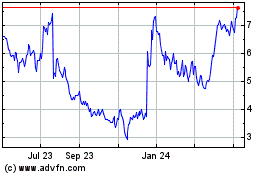false 0001660334 0001660334 2023-07-27 2023-07-27
UNITED STATES
SECURITIES AND EXCHANGE COMMISSION
Washington, D.C. 20549
FORM 8-K
CURRENT REPORT
Pursuant to Section 13 or 15(d)
of the Securities Exchange Act of 1934
Date of Report (Date of earliest event reported): July 27, 2023
Verrica Pharmaceuticals Inc.
(Exact Name of Registrant as Specified in its Charter)
|
|
|
|
|
| Delaware |
|
001-38529 |
|
46-3137900 |
| (State or Other Jurisdiction of Incorporation) |
|
(Commission File Number) |
|
(IRS Employer Identification No.) |
|
|
| 44 W. Gay St., Suite 400 West Chester, PA |
|
19380 |
| (Address of Principal Executive Offices) |
|
(Zip Code) |
Registrant’s telephone number, including area code: (484) 453-3300
Check the appropriate box below if the Form 8-K filing is intended to simultaneously satisfy the filing obligation of the registrant under any of the following provisions:
| ☐ |
Written communications pursuant to Rule 425 under the Securities Act (17 CFR 230.425) |
| ☐ |
Soliciting material pursuant to Rule 14a-12 under the Exchange Act (17 CFR 240.14a-12) |
| ☐ |
Pre-commencement communications pursuant to Rule 14d-2(b) under the Exchange Act (17 CFR 240.14d-2(b)) |
| ☐ |
Pre-commencement communications pursuant to Rule 13e-4(c) under the Exchange Act (17 CFR 240.13e-4(c)) |
Securities registered pursuant to Section 12(b) of the Securities Exchange Act of 1934:
|
|
|
|
|
| Title of each class |
|
Trading symbol |
|
Name of each exchange on which registered |
| Common Stock |
|
VRCA |
|
The Nasdaq Stock Market LLC |
Indicate by check mark whether the registrant is an emerging growth company as defined in Rule 405 of the Securities Act of 1933 (§230.405 of this chapter) or Rule 12b-2 of the Securities Exchange Act of 1934 (§240.12b-2 of this chapter).
Emerging growth company ☒
If an emerging growth company, indicate by check mark if the registrant has elected not to use the extended transition period for complying with any new or revised financial accounting standards provided pursuant to Section 13(a) of the Exchange Act. ☒
| Item 7.01 |
Regulation FD Disclosure. |
On July 27, 2023, Verrica Pharmaceuticals Inc. (the “Company”) will be posting an updated corporate presentation on its website. A copy of this presentation is furnished as Exhibit 99.1 to this Current Report on Form 8-K.
In accordance with General Instruction B.2. of Form 8-K, the information in this Item 7.01 and Exhibit 99.1 hereto shall not be deemed “filed” for purposes of Section 18 of the Securities Exchange Act of 1934, as amended (the “Exchange Act”), or otherwise subject to the liability of that section, nor shall it be deemed incorporated by reference in any of the Company’s filings under the Securities Act of 1933, as amended, or the Exchange Act, whether made before or after the date hereof, regardless of any incorporation language in such a filing, except as expressly set forth by specific reference in such a filing.
| Item 9.01 |
Financial Statements and Exhibits. |
(d) Exhibits
|
|
|
| Exhibit Number |
|
Exhibit Description |
|
|
| 99.1 |
|
Company Presentation |
|
|
| 104 |
|
Cover Page Interactive Data File (formatted as inline XBRL). |
SIGNATURES
Pursuant to the requirements of the Securities Exchange Act of 1934, the registrant has duly caused this report to be signed on its behalf by the undersigned hereunto duly authorized.
|
|
|
|
|
|
|
|
|
|
|
|
|
Verrica Pharmaceuticals Inc. |
|
|
|
|
| Date: July 27, 2023 |
|
|
|
|
|
/s/ P. Terence Kohler Jr. |
|
|
|
|
|
|
P. Terence Kohler Jr. |
|
|
|
|
|
|
Chief Financial Officer |
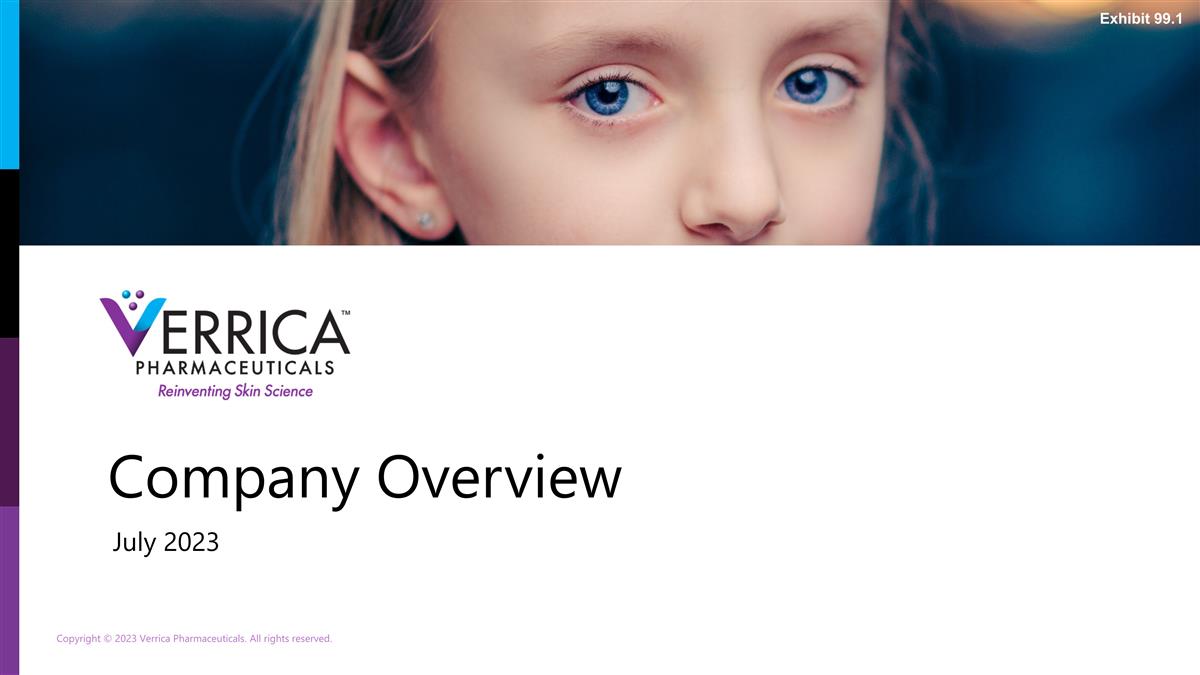
Company Overview July 2023 Copyright
© 2023 Verrica Pharmaceuticals. All rights reserved. Exhibit 99.1
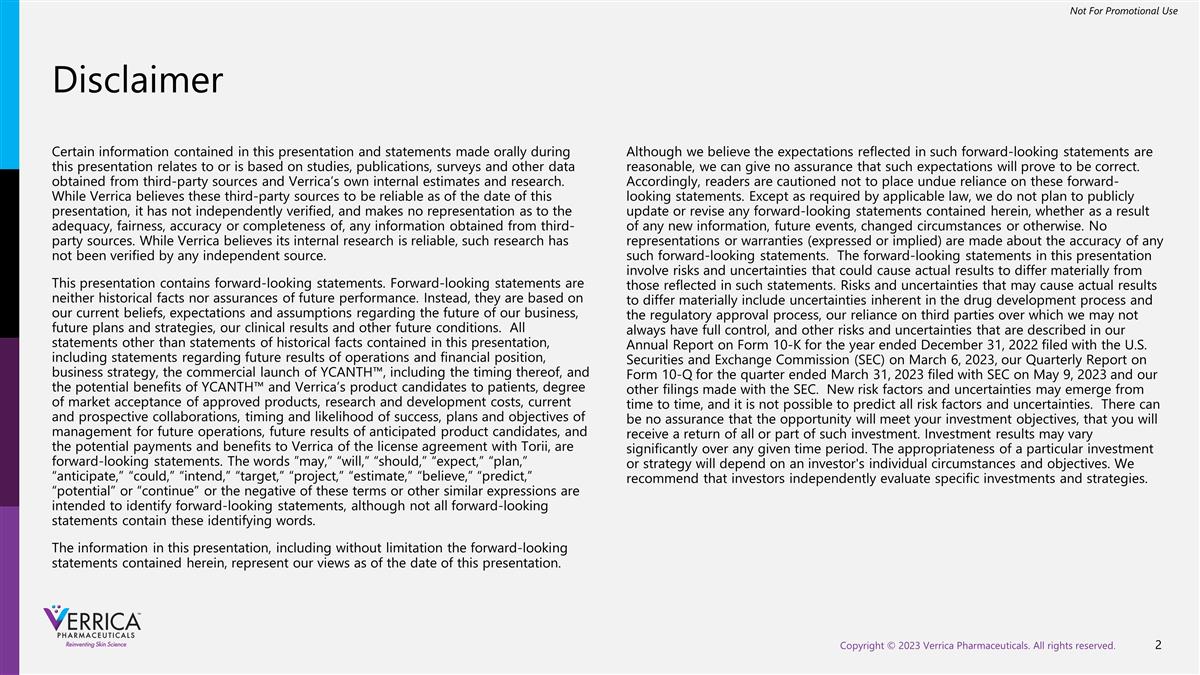
Disclaimer Certain information
contained in this presentation and statements made orally during this presentation relates to or is based on studies, publications, surveys and other data obtained from third-party sources and Verrica’s own internal estimates and research.
While Verrica believes these third-party sources to be reliable as of the date of this presentation, it has not independently verified, and makes no representation as to the adequacy, fairness, accuracy or completeness of, any information obtained
from third-party sources. While Verrica believes its internal research is reliable, such research has not been verified by any independent source. This presentation contains forward-looking statements. Forward-looking statements are neither
historical facts nor assurances of future performance. Instead, they are based on our current beliefs, expectations and assumptions regarding the future of our business, future plans and strategies, our clinical results and other future
conditions. All statements other than statements of historical facts contained in this presentation, including statements regarding future results of operations and financial position, business strategy, the commercial launch of YCANTH™,
including the timing thereof, and the potential benefits of YCANTH™ and Verrica’s product candidates to patients, degree of market acceptance of approved products, research and development costs, current and prospective collaborations,
timing and likelihood of success, plans and objectives of management for future operations, future results of anticipated product candidates, and the potential payments and benefits to Verrica of the license agreement with Torii, are forward-looking
statements. The words ”may,” “will,” “should,” “expect,” “plan,” “anticipate,” “could,” “intend,” “target,” “project,”
“estimate,” “believe,” “predict,” “potential” or “continue” or the negative of these terms or other similar expressions are intended to identify forward-looking statements, although not all
forward-looking statements contain these identifying words. The information in this presentation, including without limitation the forward-looking statements contained herein, represent our views as of the date of this
presentation. Although we believe the expectations reflected in such forward-looking statements are reasonable, we can give no assurance that such expectations will prove to be correct. Accordingly, readers are cautioned not to place undue reliance
on these forward-looking statements. Except as required by applicable law, we do not plan to publicly update or revise any forward-looking statements contained herein, whether as a result of any new information, future events, changed circumstances
or otherwise. No representations or warranties (expressed or implied) are made about the accuracy of any such forward-looking statements. The forward-looking statements in this presentation involve risks and uncertainties that could cause
actual results to differ materially from those reflected in such statements. Risks and uncertainties that may cause actual results to differ materially include uncertainties inherent in the drug development process and the regulatory approval
process, our reliance on third parties over which we may not always have full control, and other risks and uncertainties that are described in our Annual Report on Form 10-K for the year ended December 31, 2022 filed with the U.S. Securities and
Exchange Commission (SEC) on March 6, 2023, our Quarterly Report on Form 10-Q for the quarter ended March 31, 2023 filed with SEC on May 9, 2023 and our other filings made with the SEC. New risk factors and uncertainties may emerge from time
to time, and it is not possible to predict all risk factors and uncertainties. There can be no assurance that the opportunity will meet your investment objectives, that you will receive a return of all or part of such investment. Investment
results may vary significantly over any given time period. The appropriateness of a particular investment or strategy will depend on an investor's individual circumstances and objectives. We recommend that investors independently evaluate specific
investments and strategies.
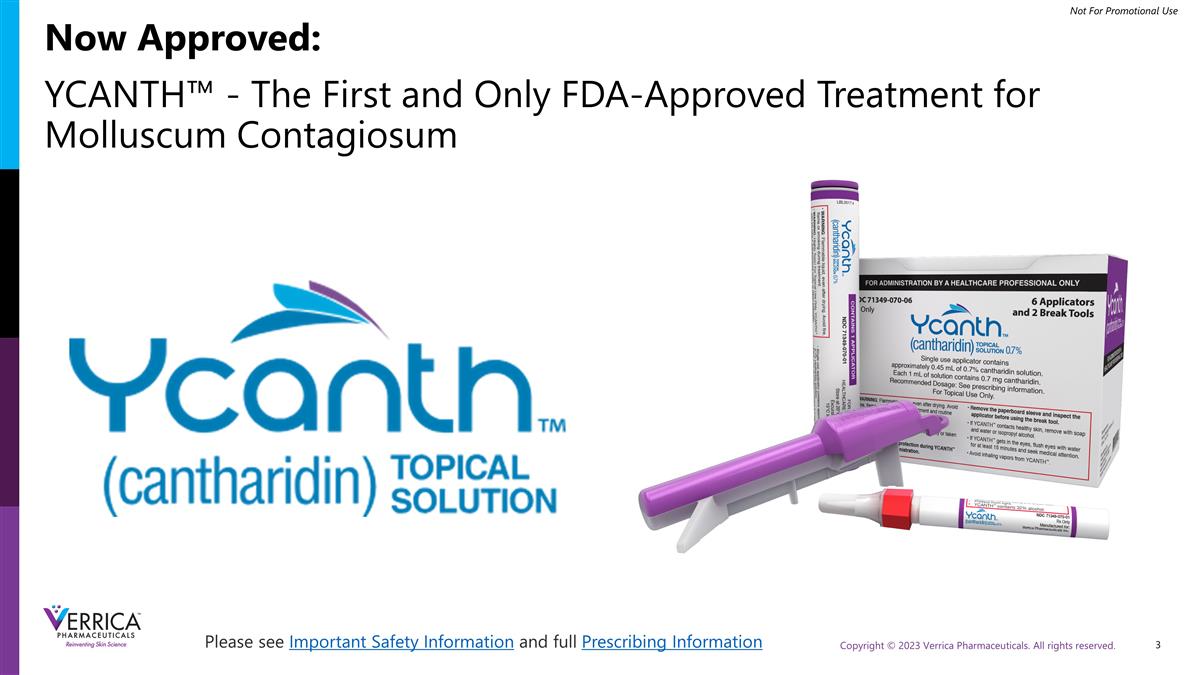
Now Approved: YCANTH™ - The
First and Only FDA-Approved Treatment for Molluscum Contagiosum Please see Important Safety Information and full Prescribing Information
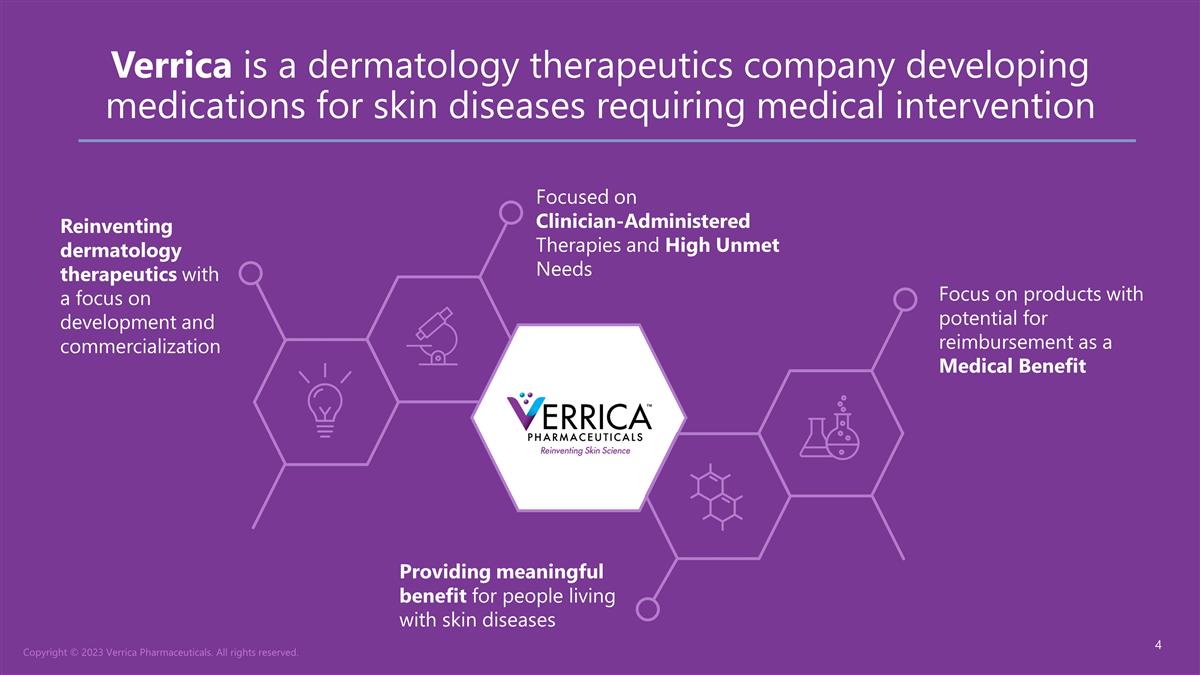
Reinventing dermatology therapeutics
with a focus on development and commercialization Focused on Clinician-Administered Therapies and High Unmet Needs Focus on products with potential for reimbursement as a Medical Benefit Providing meaningful benefit for people living with skin
diseases Copyright © 2023 Verrica Pharmaceuticals. All rights reserved. Verrica is a dermatology therapeutics company developing medications for skin diseases requiring medical intervention
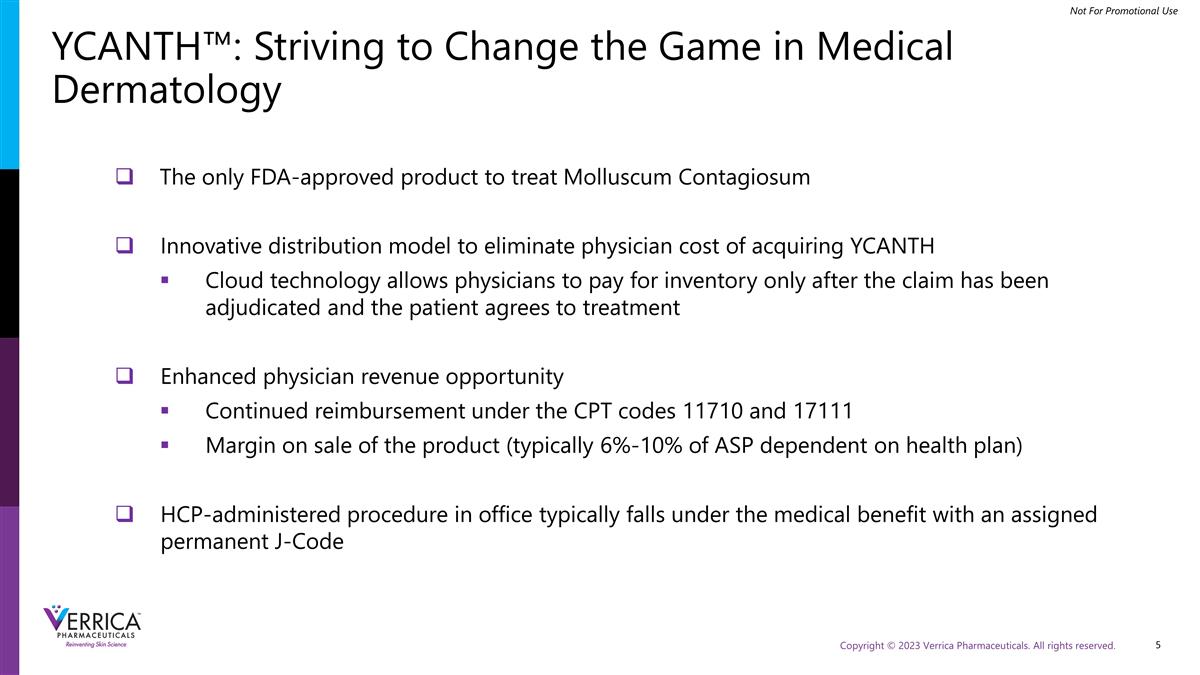
YCANTH™: Striving to Change the
Game in Medical Dermatology The only FDA-approved product to treat Molluscum Contagiosum Innovative distribution model to eliminate physician cost of acquiring YCANTH Cloud technology allows physicians to pay for inventory only after the claim has
been adjudicated and the patient agrees to treatment Enhanced physician revenue opportunity Continued reimbursement under the CPT codes 11710 and 17111 Margin on sale of the product (typically 6%-10% of ASP dependent on health plan) HCP-administered
procedure in office typically falls under the medical benefit with an assigned permanent J-Code
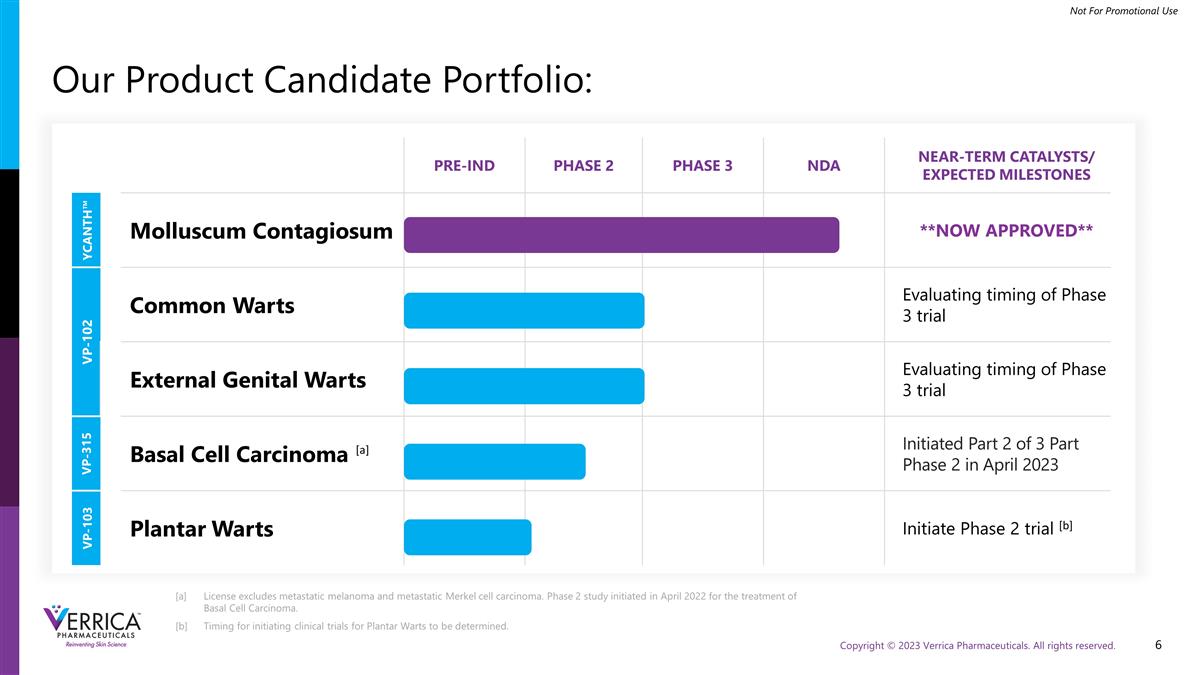
Our Product Candidate Portfolio:
Pre-IND Phase 2 Phase 3 NDA NeAR-TERM CATALYSTS/ Expected Milestones YCANTH™ Molluscum Contagiosum **NOW APPROVED** VP-102 Common Warts Evaluating timing of Phase 3 trial External Genital Warts Evaluating timing of Phase 3 trial VP-315 Basal
Cell Carcinoma Initiated Part 2 of 3 Part Phase 2 in April 2023 VP-103 Plantar Warts Initiate Phase 2 trial [a]License excludes metastatic melanoma and metastatic Merkel cell carcinoma. Phase 2 study initiated in April 2022 for the treatment of
Basal Cell Carcinoma. [b]Timing for initiating clinical trials for Plantar Warts to be determined. [b] [a]
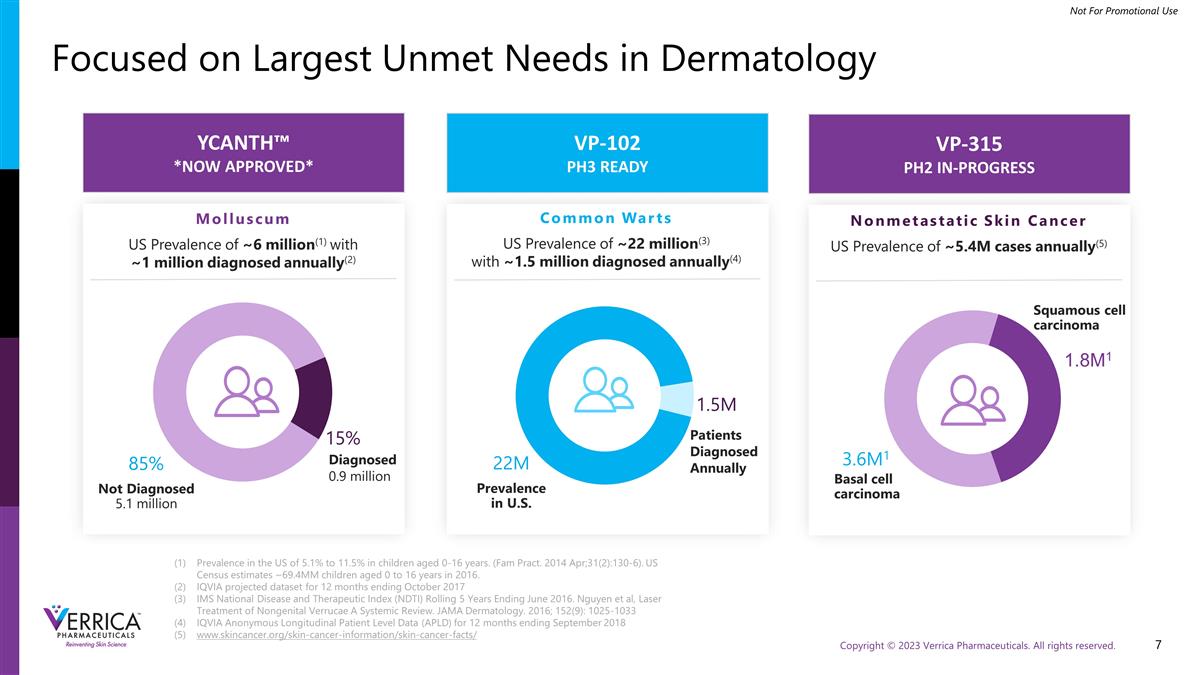
Focused on Largest Unmet Needs in
Dermatology Prevalence in the US of 5.1% to 11.5% in children aged 0-16 years. (Fam Pract. 2014 Apr;31(2):130-6). US Census estimates ~69.4MM children aged 0 to 16 years in 2016. IQVIA projected dataset for 12 months ending October 2017 IMS National
Disease and Therapeutic Index (NDTI) Rolling 5 Years Ending June 2016. Nguyen et al, Laser Treatment of Nongenital Verrucae A Systemic Review. JAMA Dermatology. 2016; 152(9): 1025-1033 IQVIA Anonymous Longitudinal Patient Level Data (APLD) for 12
months ending September 2018 www.skincancer.org/skin-cancer-information/skin-cancer-facts/ Molluscum US Prevalence of ~6 million(1) with ~1 million diagnosed annually(2) 85% Not Diagnosed 5.1 million 15% Diagnosed 0.9 million YCANTH™ *NOW
APPROVED* VP-102 PH3 READY VP-315 PH2 IN-PROGRESS Common Warts US Prevalence of ~22 million(3) with ~1.5 million diagnosed annually(4) 22M Prevalence in U.S. 1.5M Patients Diagnosed Annually Nonmetastatic Skin Cancer US Prevalence of ~5.4M cases
annually(5) 1.8M1 Basal cell carcinoma 3.6M1 Squamous cell carcinoma
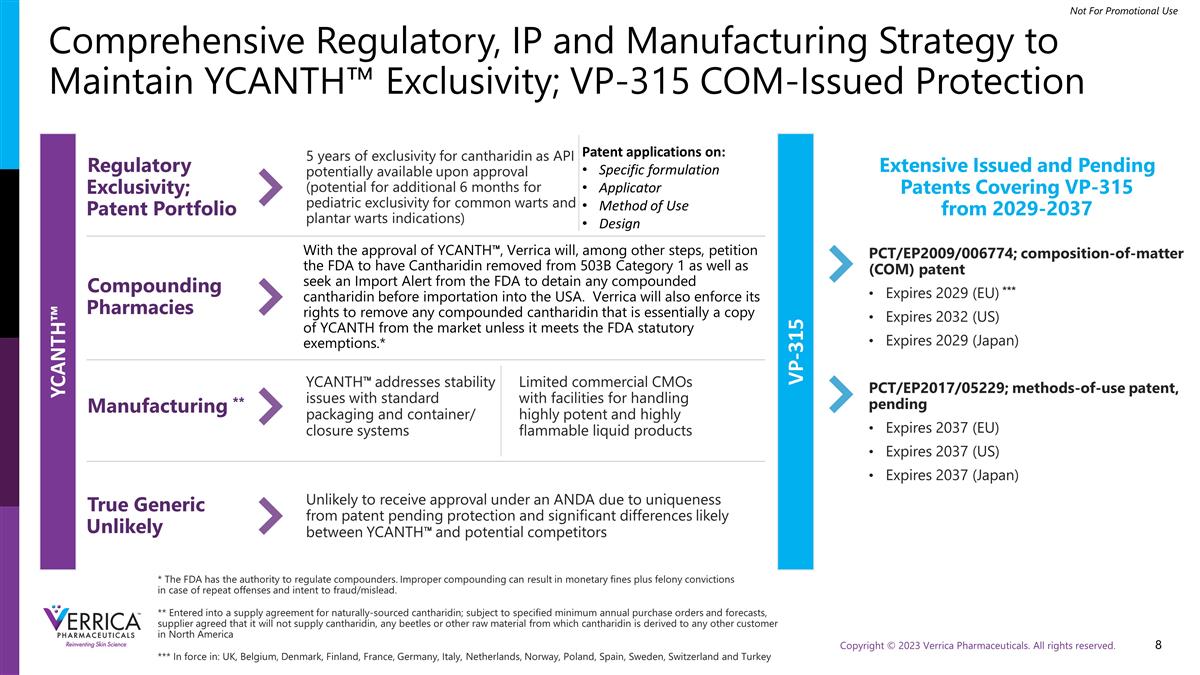
Comprehensive Regulatory, IP and
Manufacturing Strategy to Maintain YCANTH™ Exclusivity; VP-315 COM-Issued Protection Regulatory Exclusivity; Patent Portfolio 5 years of exclusivity for cantharidin as API potentially available upon approval (potential for additional 6 months
for pediatric exclusivity for common warts and plantar warts indications) Compounding Pharmacies With the approval of YCANTH™, Verrica will, among other steps, petition the FDA to have Cantharidin removed from 503B Category 1 as well as seek
an Import Alert from the FDA to detain any compounded cantharidin before importation into the USA. Verrica will also enforce its rights to remove any compounded cantharidin that is essentially a copy of YCANTH from the market unless it meets the FDA
statutory exemptions.* Manufacturing ** YCANTH™ addresses stability issues with standard packaging and container/ closure systems True Generic Unlikely Unlikely to receive approval under an ANDA due to uniqueness from patent pending protection
and significant differences likely between YCANTH™ and potential competitors Limited commercial CMOs with facilities for handling highly potent and highly flammable liquid products * The FDA has the authority to regulate compounders. Improper
compounding can result in monetary fines plus felony convictions in case of repeat offenses and intent to fraud/mislead. ** Entered into a supply agreement for naturally-sourced cantharidin; subject to specified minimum annual purchase orders and
forecasts, supplier agreed that it will not supply cantharidin, any beetles or other raw material from which cantharidin is derived to any other customer in North America YCANTH™ VP-315 Patent applications on: Specific formulation Applicator
Method of Use Design Extensive Issued and Pending Patents Covering VP-315 from 2029-2037 PCT/EP2009/006774; composition-of-matter (COM) patent Expires 2029 (EU) *** Expires 2032 (US) Expires 2029 (Japan) PCT/EP2017/05229; methods-of-use patent,
pending Expires 2037 (EU) Expires 2037 (US) Expires 2037 (Japan) *** In force in: UK, Belgium, Denmark, Finland, France, Germany, Italy, Netherlands, Norway, Poland, Spain, Sweden, Switzerland and Turkey
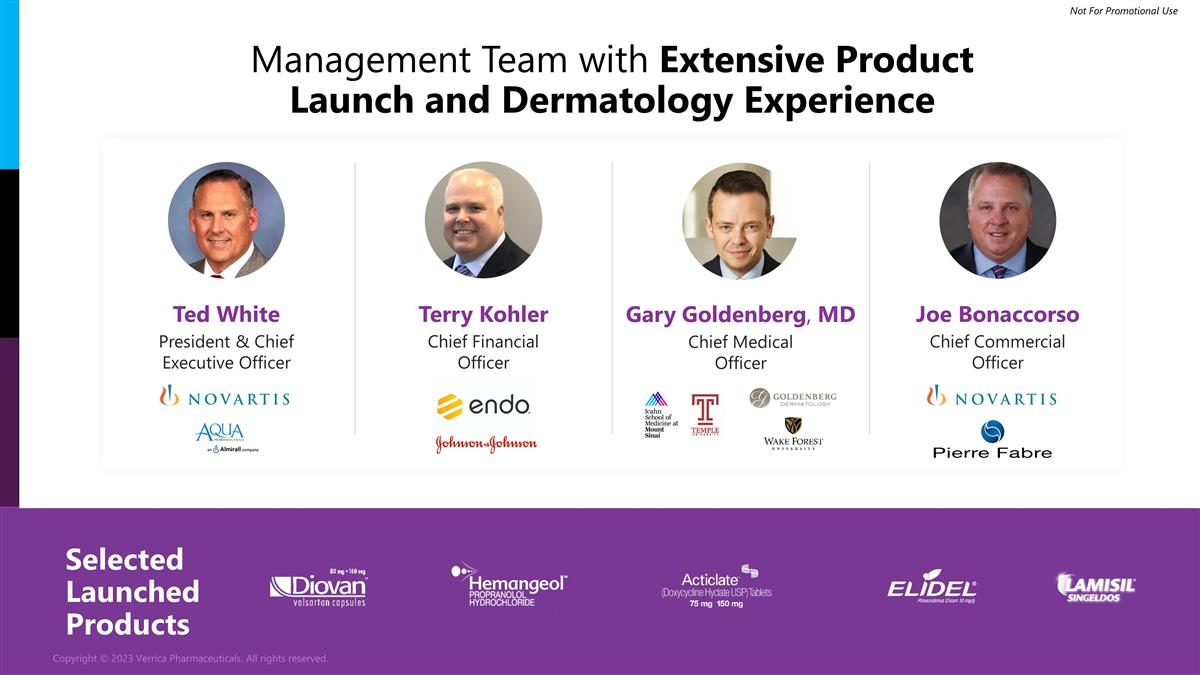
Management Team with Extensive Product
Launch and Dermatology Experience Selected Launched Products Terry Kohler Chief Financial Officer Ted White President & Chief Executive Officer Chief Medical Officer Joe Bonaccorso Chief Commercial Officer Gary Goldenberg, MD Copyright ©
2023 Verrica Pharmaceuticals. All rights reserved.
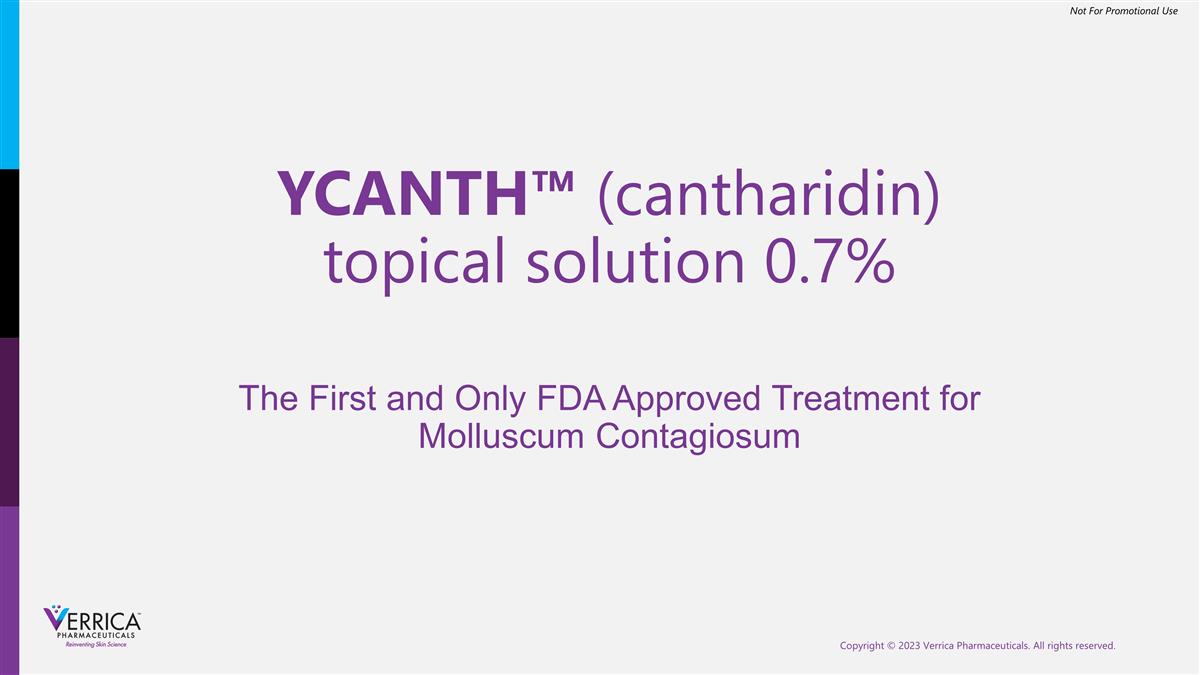
YCANTH™ (cantharidin) topical
solution 0.7% The First and Only FDA Approved Treatment for Molluscum Contagiosum
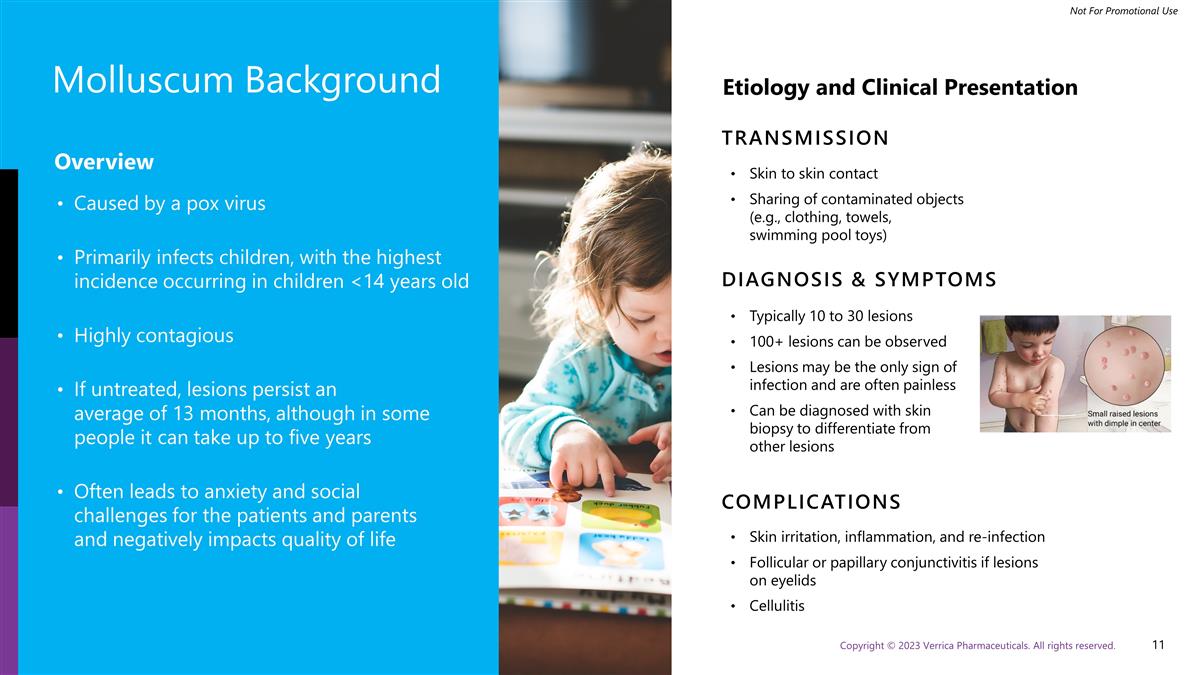
Molluscum Background Overview
Caused by a pox virus Primarily infects children, with the highest incidence occurring in children <14 years old Highly contagious If untreated, lesions persist an average of 13 months, although in some people it can take up to five years Often
leads to anxiety and social challenges for the patients and parents and negatively impacts quality of life Etiology and Clinical Presentation TRANSMISSION Skin to skin contact Sharing of contaminated objects (e.g., clothing, towels, swimming pool
toys) DIAGNOSIS & SYMPTOMS Typically 10 to 30 lesions 100+ lesions can be observed Lesions may be the only sign of infection and are often painless Can be diagnosed with skin biopsy to differentiate from other lesions COMPLICATIONS Skin
irritation, inflammation, and re-infection Follicular or papillary conjunctivitis if lesions on eyelids Cellulitis
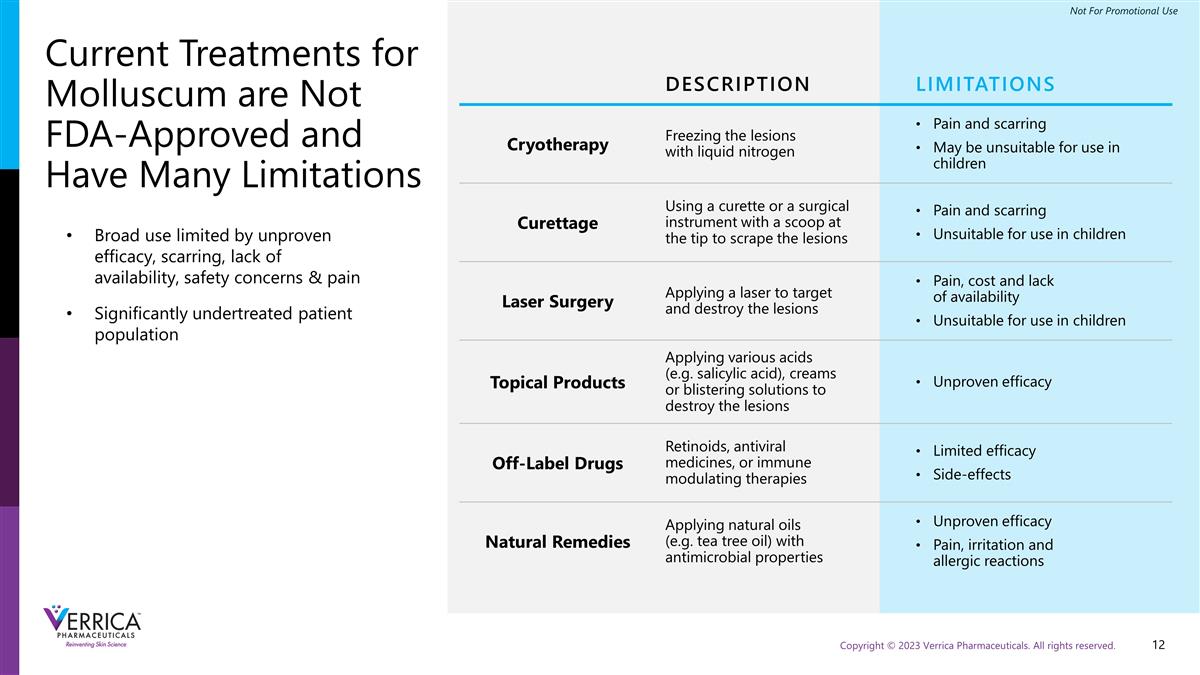
Current Treatments for Molluscum
are Not FDA-Approved and Have Many Limitations DESCRIPTION LIMITATIONS Cryotherapy Freezing the lesions with liquid nitrogen Pain and scarring May be unsuitable for use in children Curettage Using a curette or a surgical instrument with a scoop at
the tip to scrape the lesions Pain and scarring Unsuitable for use in children Laser Surgery Applying a laser to target and destroy the lesions Pain, cost and lack of availability Unsuitable for use in children Topical Products Applying various
acids (e.g. salicylic acid), creams or blistering solutions to destroy the lesions Unproven efficacy Off-Label Drugs Retinoids, antiviral medicines, or immune modulating therapies Limited efficacy Side-effects Natural Remedies Applying natural oils
(e.g. tea tree oil) with antimicrobial properties Unproven efficacy Pain, irritation and allergic reactions Broad use limited by unproven efficacy, scarring, lack of availability, safety concerns & pain Significantly undertreated patient
population
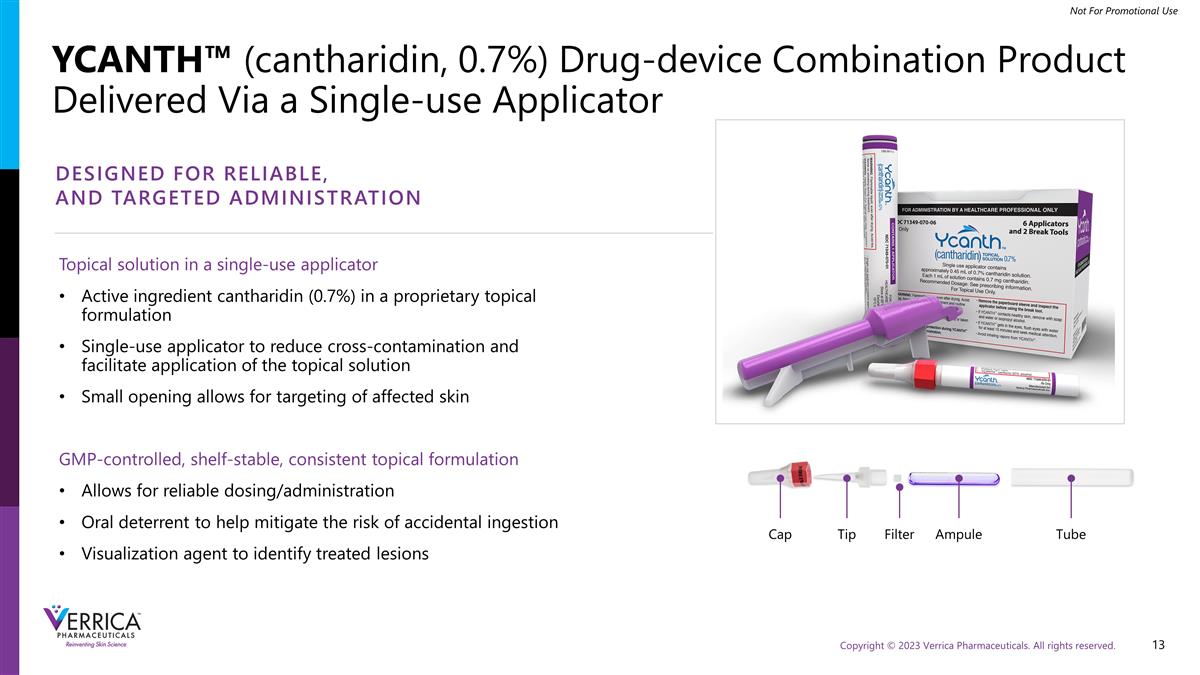
YCANTH™ (cantharidin, 0.7%)
Drug-device Combination Product Delivered Via a Single-use Applicator Topical solution in a single-use applicator Active ingredient cantharidin (0.7%) in a proprietary topical formulation Single-use applicator to reduce cross-contamination and
facilitate application of the topical solution Small opening allows for targeting of affected skin GMP-controlled, shelf-stable, consistent topical formulation Allows for reliable dosing/administration Oral deterrent to help mitigate the risk of
accidental ingestion Visualization agent to identify treated lesions Cap Tip Filter Ampule Tube DESIGNED FOR RELIABLE, AND TARGETED ADMINISTRATION
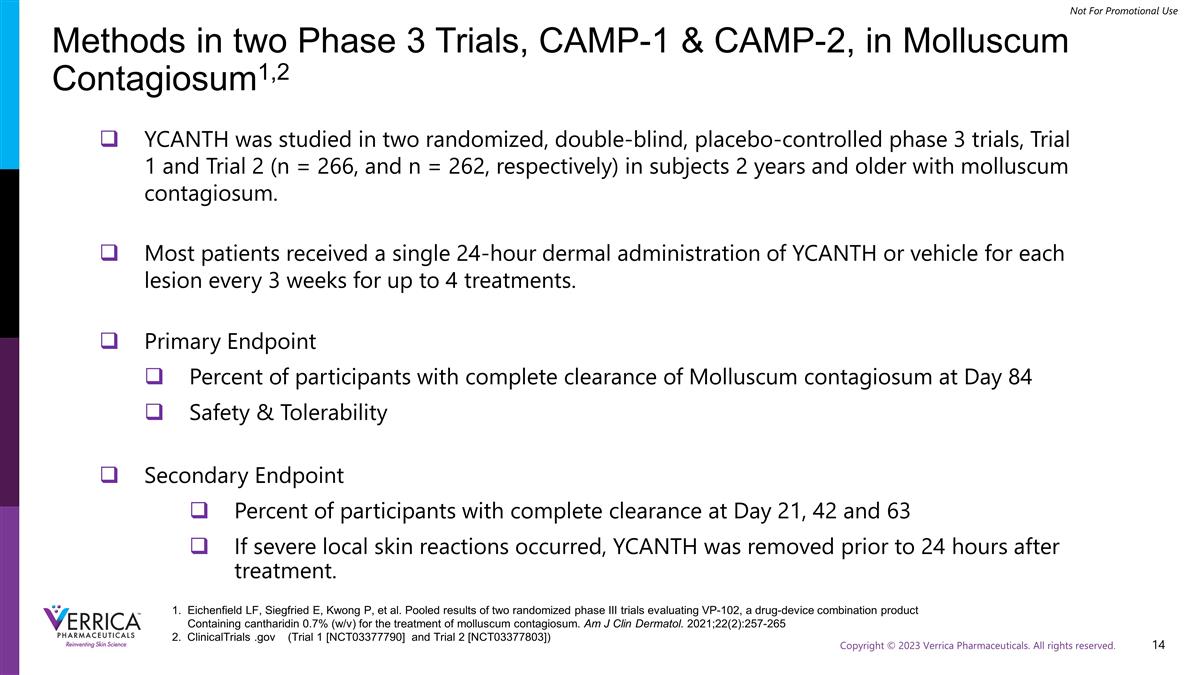
Methods in two Phase 3 Trials,
CAMP-1 & CAMP-2, in Molluscum Contagiosum1,2 1. Eichenfield LF, Siegfried E, Kwong P, et al. Pooled results of two randomized phase III trials evaluating VP-102, a drug-device combination product
Containing cantharidin 0.7% (w/v) for the treatment of molluscum contagiosum. Am J Clin Dermatol. 2021;22(2):257-265 2. ClinicalTrials .gov (Trial 1 [NCT03377790] and
Trial 2 [NCT03377803]) wo identically designed, randomized, double-blinded, multicenter, vehicle-controlled trials YCANTH was studied in two randomized, double-blind, placebo-controlled phase 3 trials, Trial 1 and Trial 2 (n = 266,
and n = 262, respectively) in subjects 2 years and older with molluscum contagiosum. Most patients received a single 24-hour dermal administration of YCANTH or vehicle for each lesion every 3 weeks for up to 4 treatments. Primary
Endpoint Percent of participants with complete clearance of Molluscum contagiosum at Day 84 Safety & Tolerability Secondary Endpoint Percent of participants with complete clearance at Day 21, 42 and 63 If severe local skin
reactions occurred, YCANTH was removed prior to 24 hours after treatment.
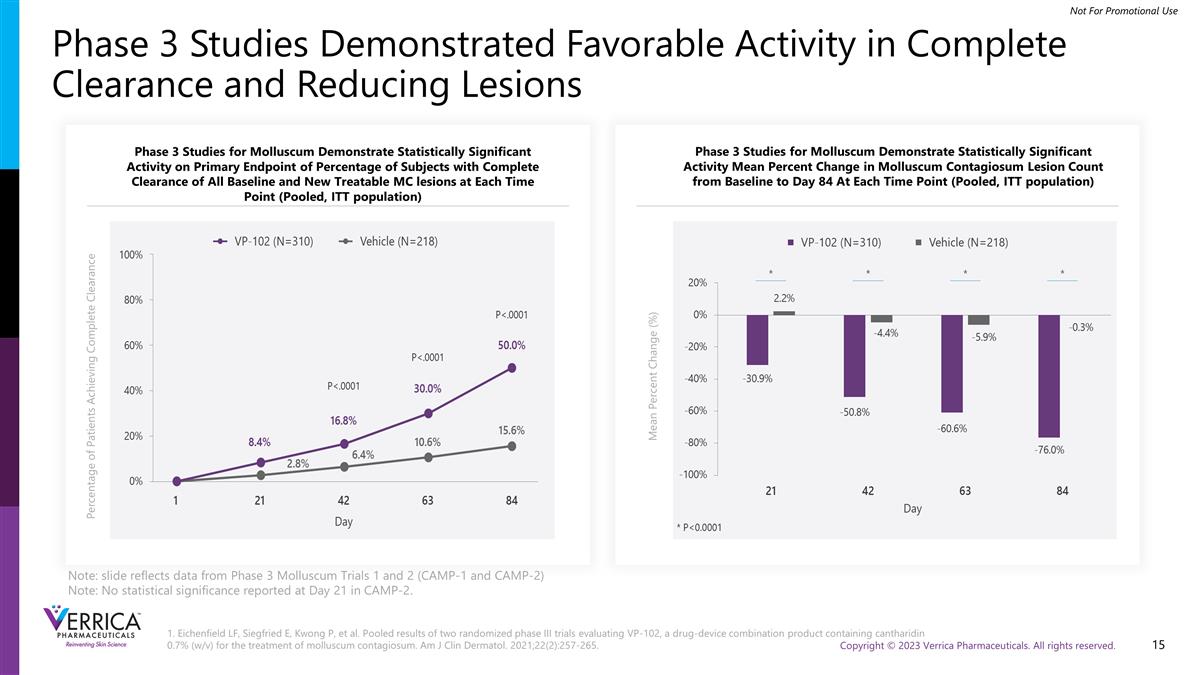
Phase 3 Studies Demonstrated
Favorable Activity in Complete Clearance and Reducing Lesions Phase 3 Studies for Molluscum Demonstrate Statistically Significant Activity on Primary Endpoint of Percentage of Subjects with Complete Clearance of All Baseline and New Treatable MC
lesions at Each Time Point (Pooled, ITT population) Phase 3 Studies for Molluscum Demonstrate Statistically Significant Activity Mean Percent Change in Molluscum Contagiosum Lesion Count from Baseline to Day 84 At Each Time Point (Pooled, ITT
population) 1. Eichenfield LF, Siegfried E, Kwong P, et al. Pooled results of two randomized phase III trials evaluating VP-102, a drug-device combination product containing cantharidin 0.7% (w/v) for the treatment of molluscum contagiosum. Am J
Clin Dermatol. 2021;22(2):257-265. Mean Percent Change (%) Note: slide reflects data from Phase 3 Molluscum Trials 1 and 2 (CAMP-1 and CAMP-2) Note: No statistical significance reported at Day 21 in CAMP-2. Percentage of Patients Achieving Complete
Clearance
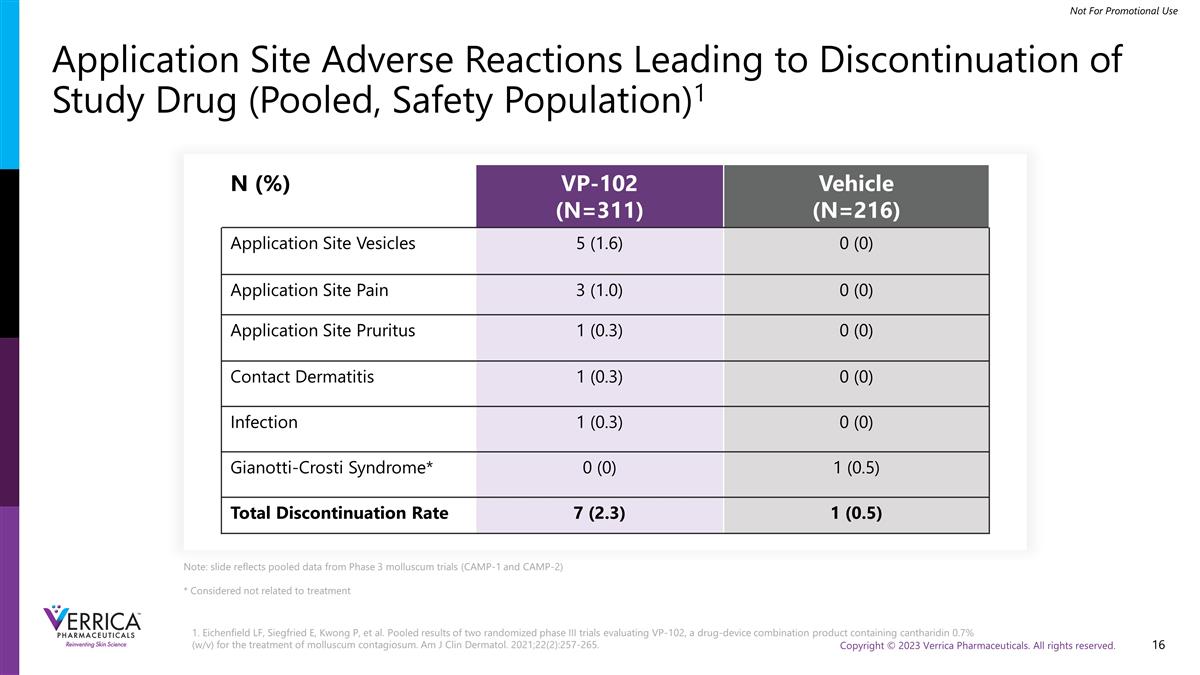
Application Site Adverse Reactions
Leading to Discontinuation of Study Drug (Pooled, Safety Population)1 Note: slide reflects pooled data from Phase 3 molluscum trials (CAMP-1 and CAMP-2) * Considered not related to treatment N (%) VP-102 (N=311) Vehicle (N=216) Application Site
Vesicles 5 (1.6) 0 (0) Application Site Pain 3 (1.0) 0 (0) Application Site Pruritus 1 (0.3) 0 (0) Contact Dermatitis 1 (0.3) 0 (0) Infection 1 (0.3) 0 (0) Gianotti-Crosti Syndrome* 0 (0) 1 (0.5) Total Discontinuation Rate 7 (2.3) 1 (0.5) 1.
Eichenfield LF, Siegfried E, Kwong P, et al. Pooled results of two randomized phase III trials evaluating VP-102, a drug-device combination product containing cantharidin 0.7% (w/v) for the treatment of molluscum contagiosum. Am J Clin Dermatol.
2021;22(2):257-265.
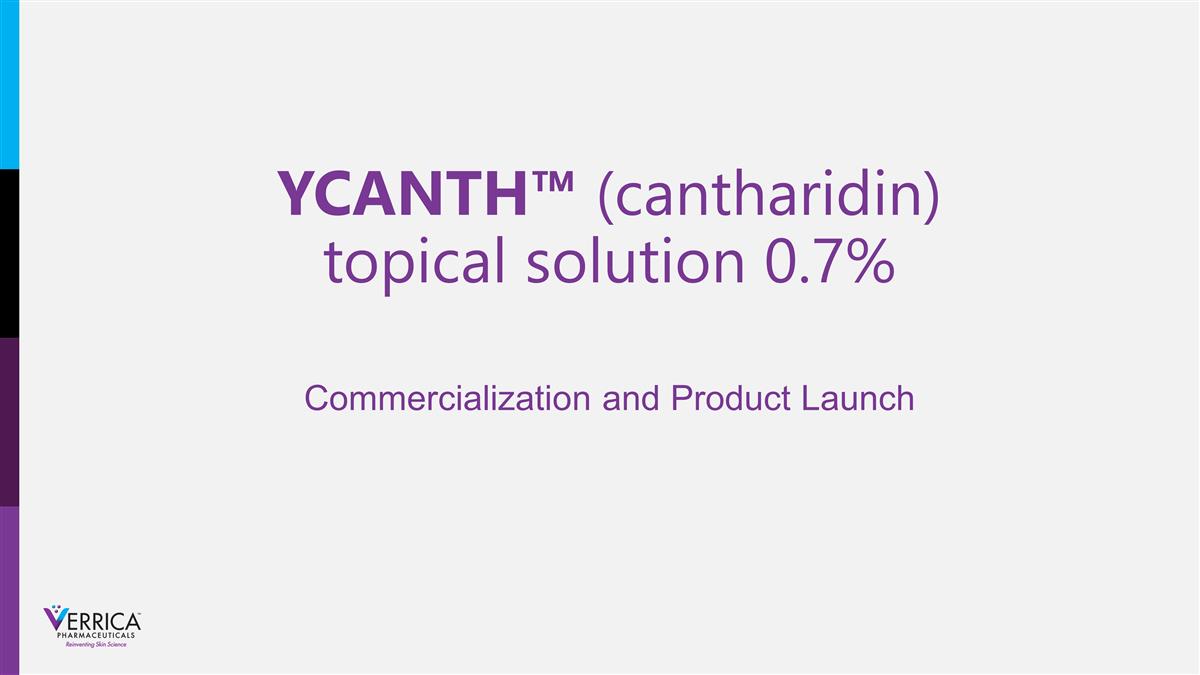
YCANTH™ (cantharidin) topical
solution 0.7% Commercialization and Product Launch
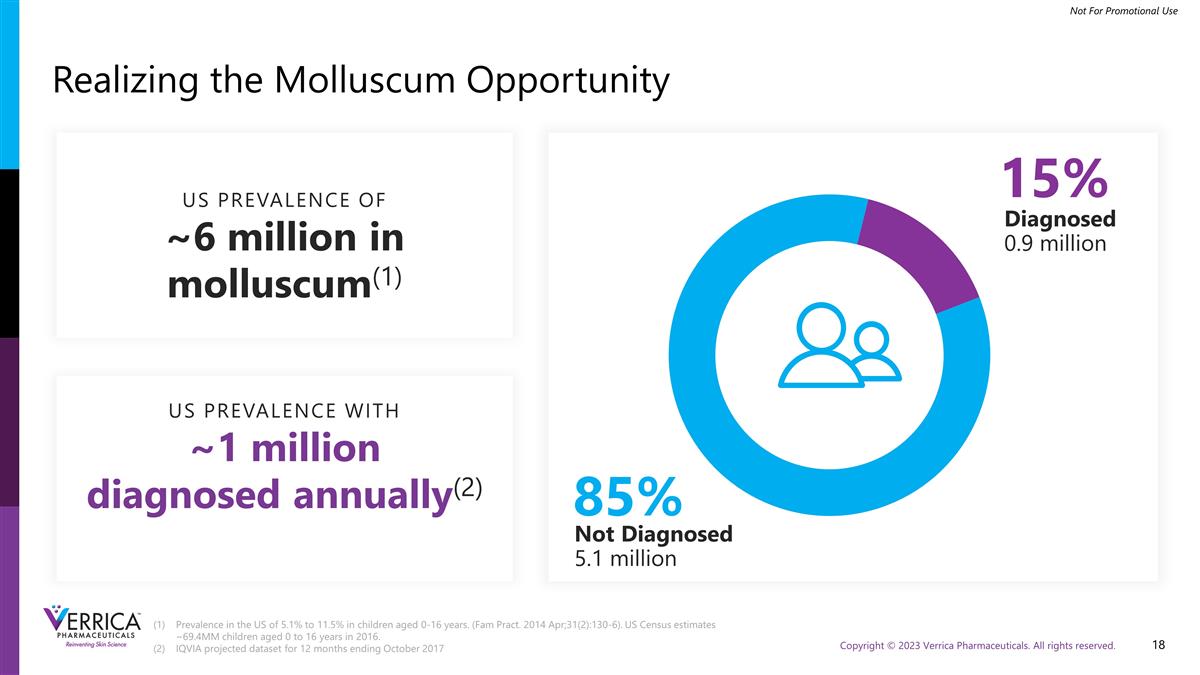
Realizing the Molluscum Opportunity
Prevalence in the US of 5.1% to 11.5% in children aged 0-16 years. (Fam Pract. 2014 Apr;31(2):130-6). US Census estimates ~69.4MM children aged 0 to 16 years in 2016. IQVIA projected dataset for 12 months ending October 2017 Not Diagnosed 5.1
million US PREVALENCE OF ~6 million in molluscum(1) 85% 15% Diagnosed 0.9 million US PREVALENCE WITH ~1 million diagnosed annually(2)

Dermatologists are Familiar with
Cantharidin & Would Use if Available Pompei DT et al. Cantharidin Therapy: Practice patterns and attitudes of health care providers. Journal of the American Academy of Dermatology. 2013; 68(6). Survey of 400 healthcare providers, 87.7% of
responders were US based dermatologists. Company survey of 40 physicians. Physicians who do not use Cantharidin stated inaccessibility as a primary reason why they are not using(1) Physicians reported they would use YCANTH™ if the cost of the
drug was covered(2) 87%
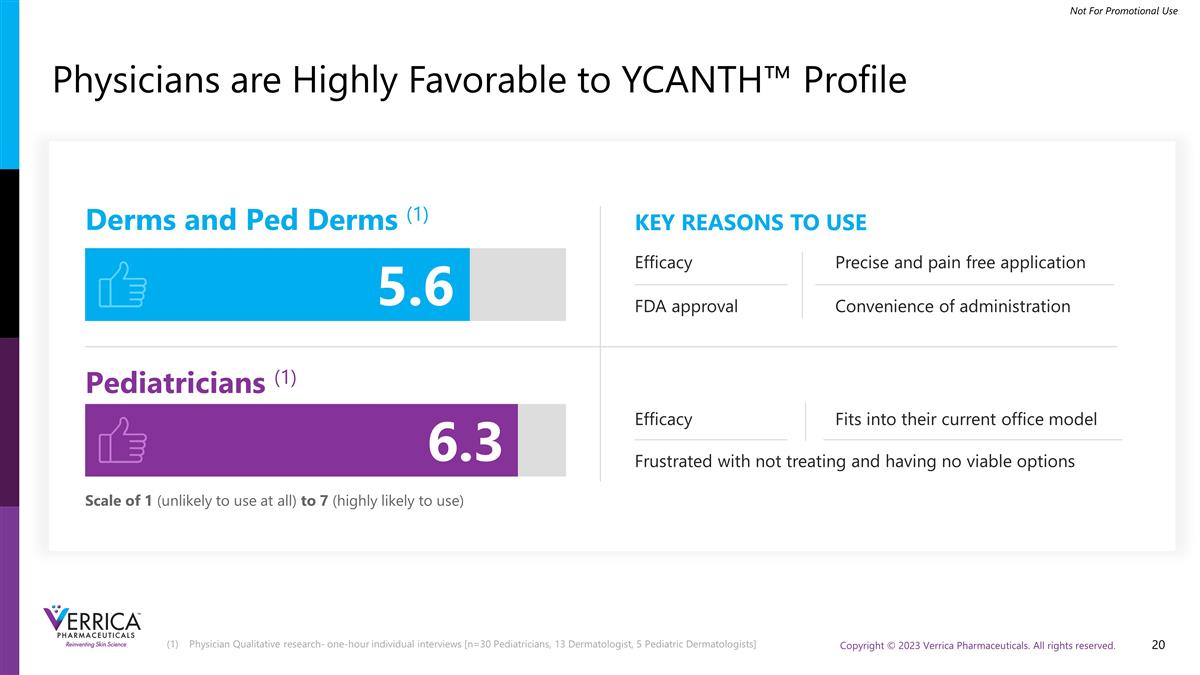
Physicians are Highly Favorable to
YCANTH™ Profile Physician Qualitative research- one-hour individual interviews [n=30 Pediatricians, 13 Dermatologist, 5 Pediatric Dermatologists] Derms and Ped Derms (1) Pediatricians (1) 5.6 6.3 Efficacy Efficacy KEY REASONS TO USE
Convenience of administration Frustrated with not treating and having no viable options Scale of 1 (unlikely to use at all) to 7 (highly likely to use) Precise and pain free application FDA approval Fits into their current office model
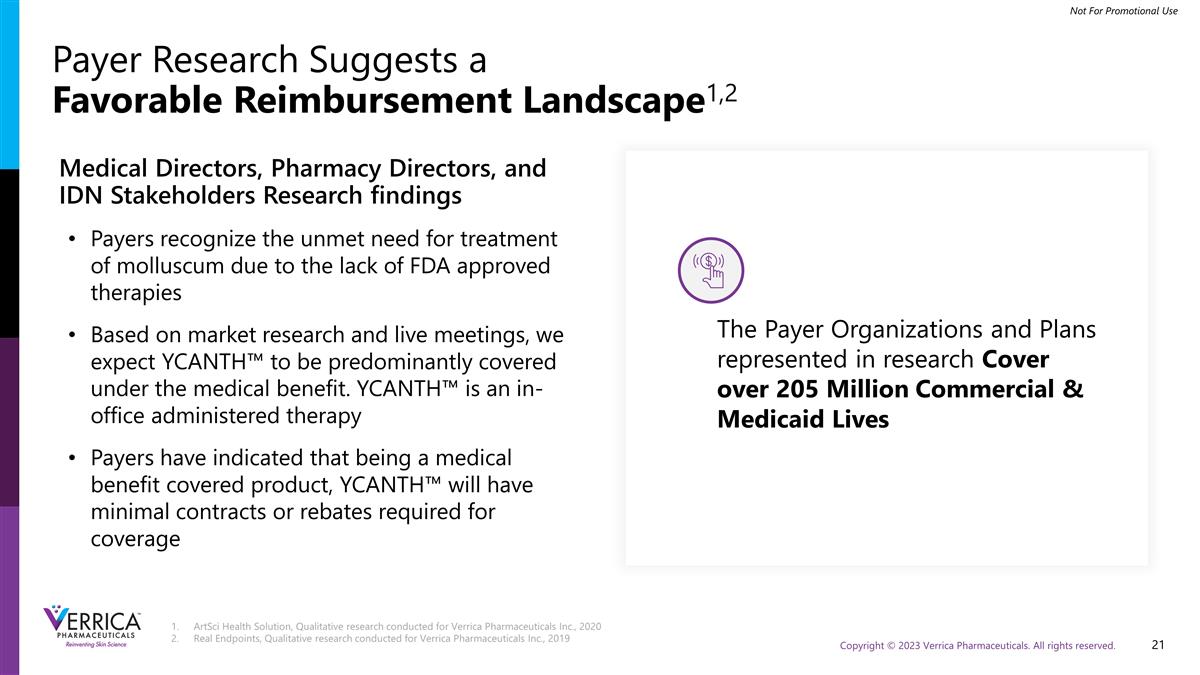
after Payer Research Suggests a
Favorable Reimbursement Landscape1,2 ArtSci Health Solution, Qualitative research conducted for Verrica Pharmaceuticals Inc., 2020 Real Endpoints, Qualitative research conducted for Verrica Pharmaceuticals Inc., 2019 The Payer Organizations and
Plans represented in research Cover over 205 Million Commercial & Medicaid Lives Medical Directors, Pharmacy Directors, and IDN Stakeholders Research findings Payers recognize the unmet need for treatment of molluscum due to the lack of FDA
approved therapies Based on market research and live meetings, we expect YCANTH™ to be predominantly covered under the medical benefit. YCANTH™ is an in-office administered therapy Payers have indicated that being a medical benefit
covered product, YCANTH™ will have minimal contracts or rebates required for coverage
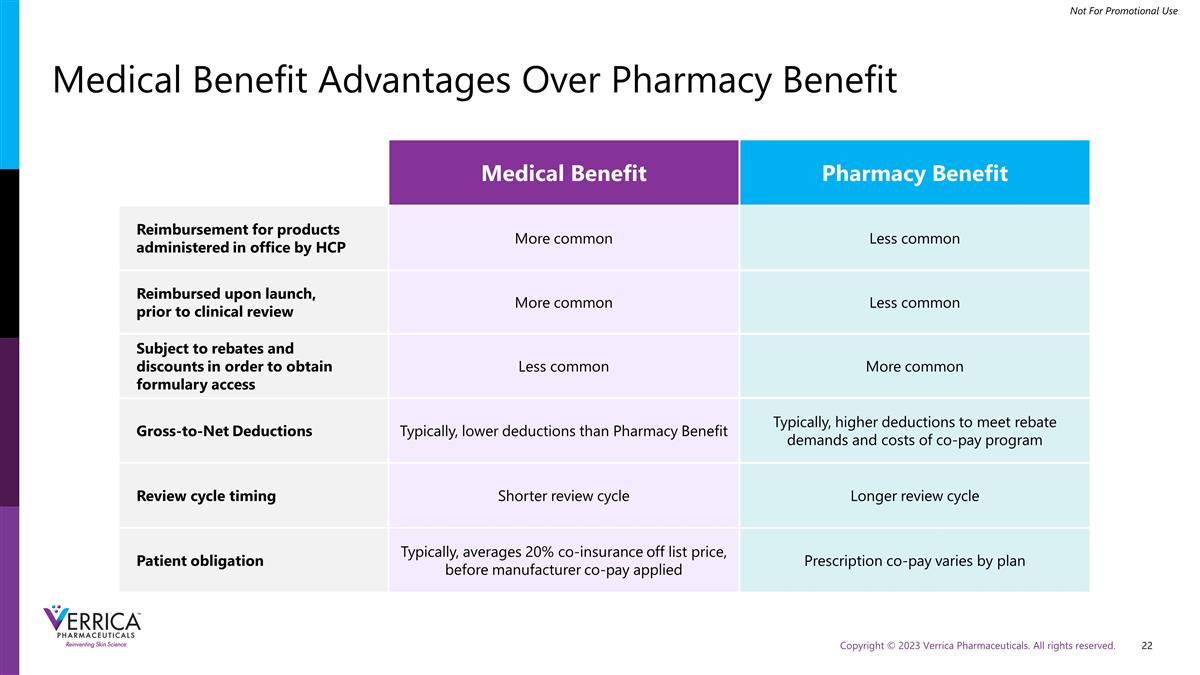
Medical Benefit Advantages Over
Pharmacy Benefit Medical Benefit Pharmacy Benefit Reimbursement for products administered in office by HCP More common Less common Reimbursed upon launch, prior to clinical review More common Less common Subject to rebates and discounts in order to
obtain formulary access Less common More common Gross-to-Net Deductions Typically, lower deductions than Pharmacy Benefit Typically, higher deductions to meet rebate demands and costs of co-pay program Review cycle timing Shorter review cycle Longer
review cycle Patient obligation Typically, averages 20% co-insurance off list price, before manufacturer co-pay applied Prescription co-pay varies by plan
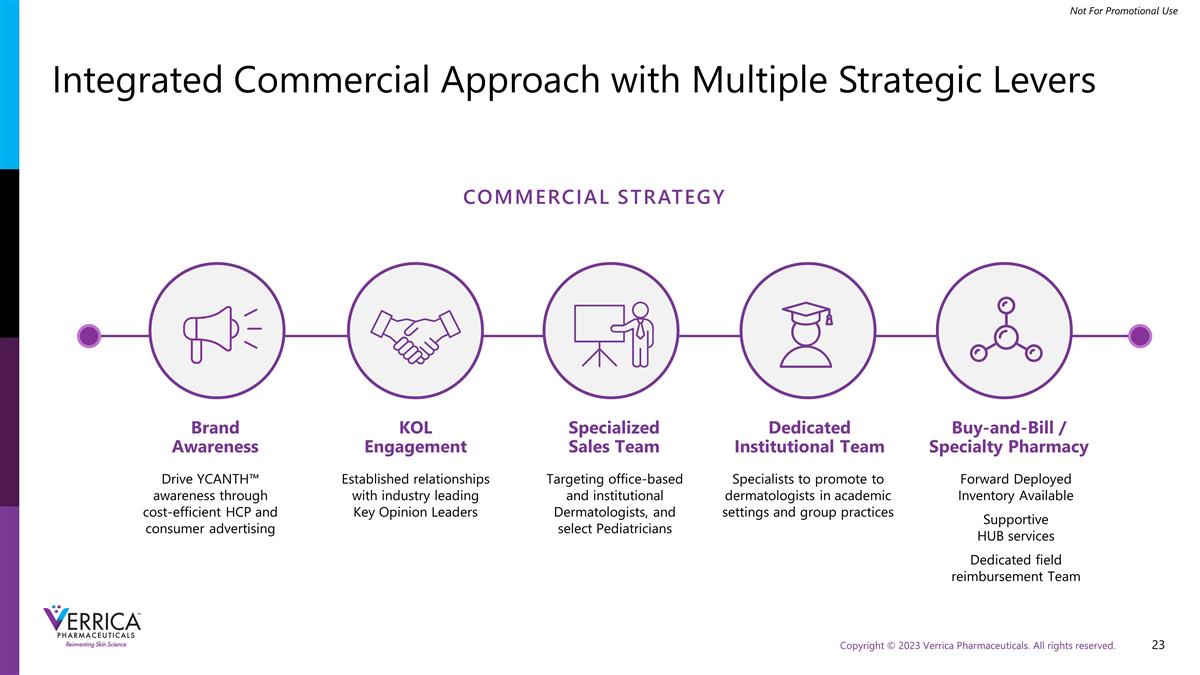
Dedicated Institutional Team
Specialists to promote to dermatologists in academic settings and group practices Integrated Commercial Approach with Multiple Strategic Levers Brand Awareness Drive YCANTH™ awareness through cost-efficient HCP and consumer advertising
Specialized Sales Team Targeting office-based and institutional Dermatologists, and select Pediatricians Buy-and-Bill / Specialty Pharmacy Forward Deployed Inventory Available Supportive HUB services Dedicated field reimbursement Team KOL Engagement
Established relationships with industry leading Key Opinion Leaders COMMERCIAL STRATEGY
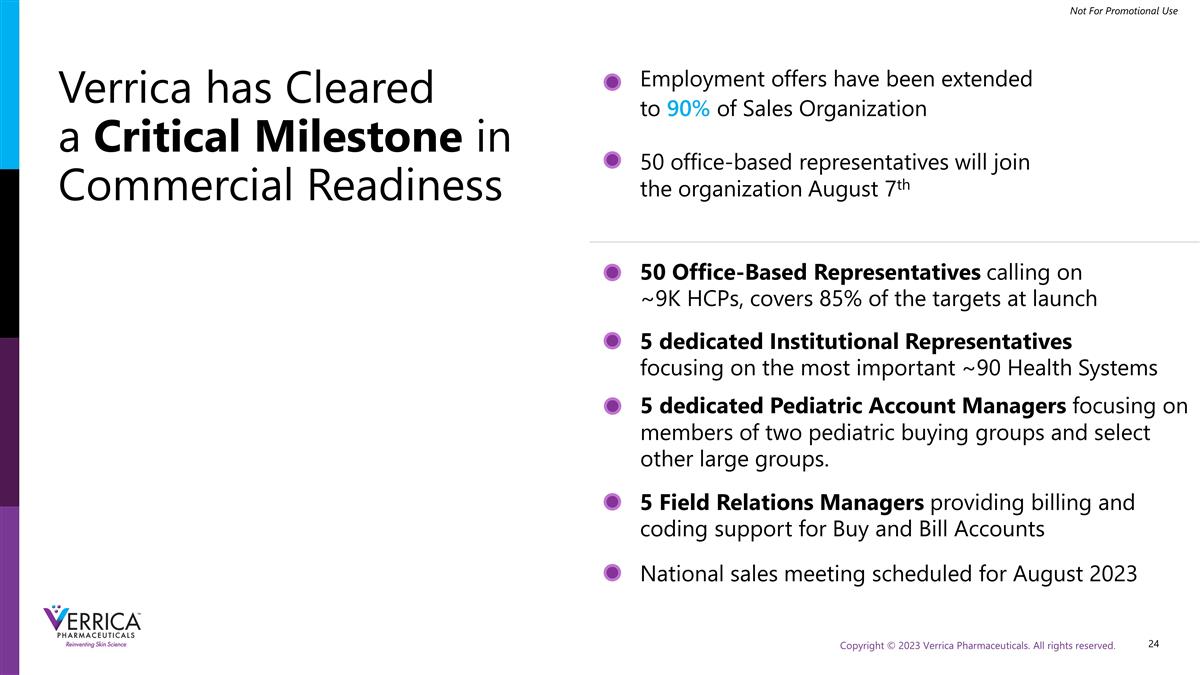
Verrica has Cleared a Critical
Milestone in Commercial Readiness Employment offers have been extended to 90% of Sales Organization 50 office-based representatives will join the organization August 7th National sales meeting scheduled for August 2023 50 Office-Based
Representatives calling on ~9K HCPs, covers 85% of the targets at launch 5 dedicated Institutional Representatives focusing on the most important ~90 Health Systems 5 Field Relations Managers providing billing and coding support for Buy and Bill
Accounts 5 dedicated Pediatric Account Managers focusing on members of two pediatric buying groups and select other large groups.
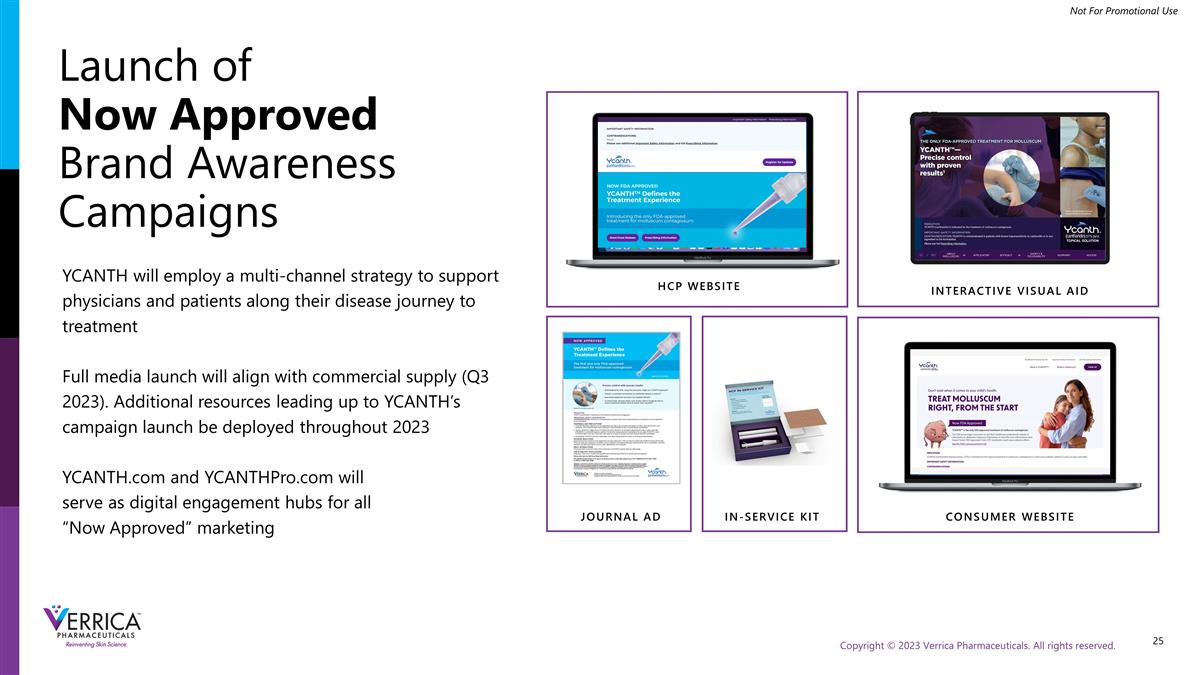
Launch of Now Approved Brand
Awareness Campaigns YCANTH will employ a multi-channel strategy to support physicians and patients along their disease journey to treatment Full media launch will align with commercial supply (Q3 2023). Additional resources leading up to
YCANTH’s campaign launch be deployed throughout 2023 YCANTH.com and YCANTHPro.com will serve as digital engagement hubs for all “Now Approved” marketing CONSUMER WEBSITE IN-SERVICE KIT HCP WEBSITE JOURNAL AD INTERACTIVE VISUAL
AID
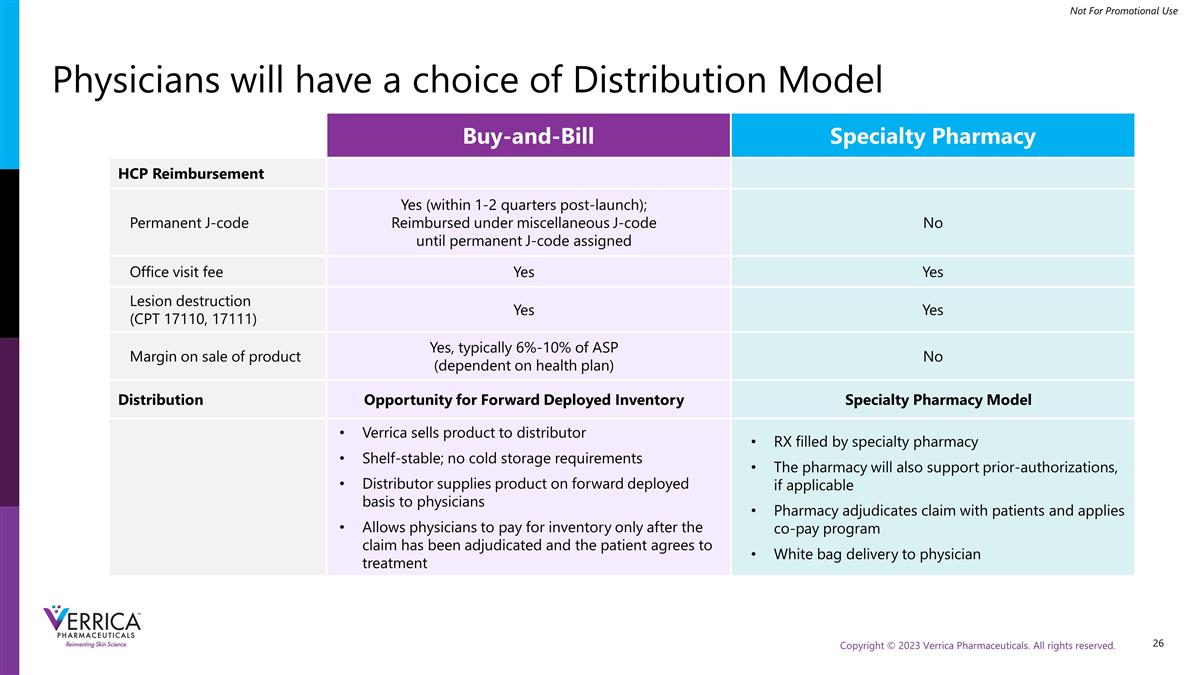
Physicians will have a choice of
Distribution Model Buy-and-Bill Specialty Pharmacy HCP Reimbursement Permanent J-code Yes (within 1-2 quarters post-launch); Reimbursed under miscellaneous J-code until permanent J-code assigned No Office visit fee Yes Yes Lesion destruction (CPT
17110, 17111) Yes Yes Margin on sale of product Yes, typically 6%-10% of ASP (dependent on health plan) No Distribution Opportunity for Forward Deployed Inventory Specialty Pharmacy Model Verrica sells product to distributor Shelf-stable; no cold
storage requirements Distributor supplies product on forward deployed basis to physicians Allows physicians to pay for inventory only after the claim has been adjudicated and the patient agrees to treatment RX filled by specialty pharmacy The
pharmacy will also support prior-authorizations, if applicable Pharmacy adjudicates claim with patients and applies co-pay program White bag delivery to physician
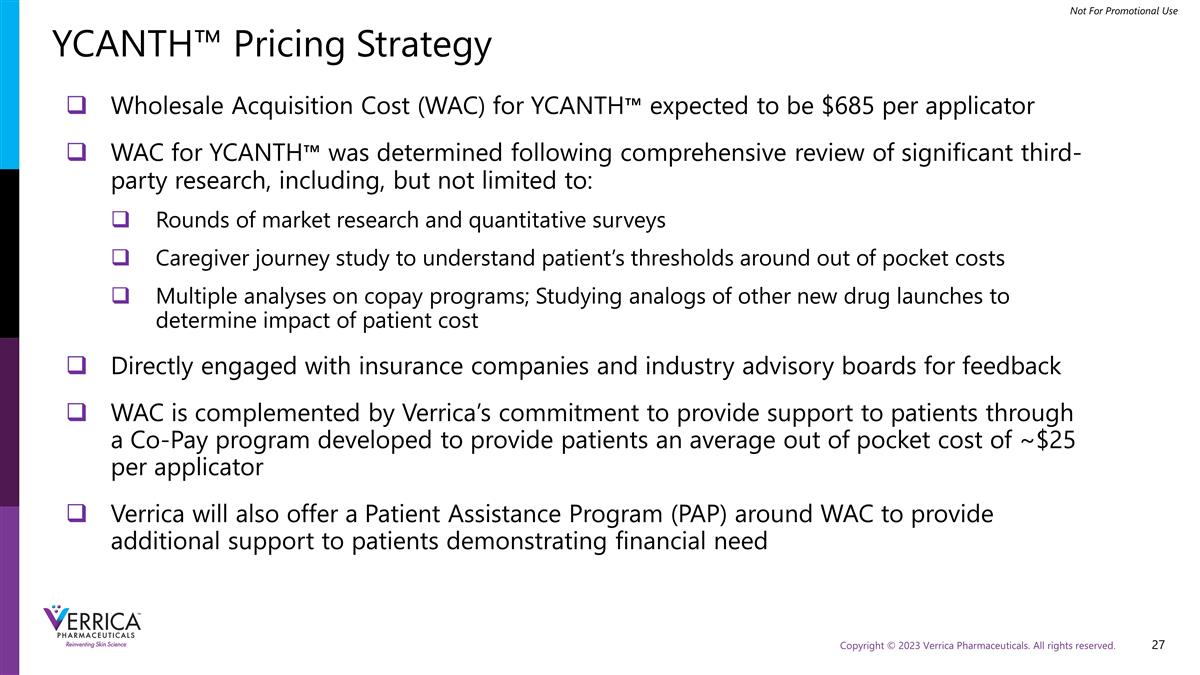
YCANTH™ Pricing Strategy
Wholesale Acquisition Cost (WAC) for YCANTH™ expected to be $685 per applicator WAC for YCANTH™ was determined following comprehensive review of significant third-party research, including, but not limited to: Rounds of market research
and quantitative surveys Caregiver journey study to understand patient’s thresholds around out of pocket costs Multiple analyses on copay programs; Studying analogs of other new drug launches to determine impact of patient cost Directly
engaged with insurance companies and industry advisory boards for feedback WAC is complemented by Verrica’s commitment to provide support to patients through a Co-Pay program developed to provide patients an average out of pocket cost of ~$25
per applicator Verrica will also offer a Patient Assistance Program (PAP) around WAC to provide additional support to patients demonstrating financial need
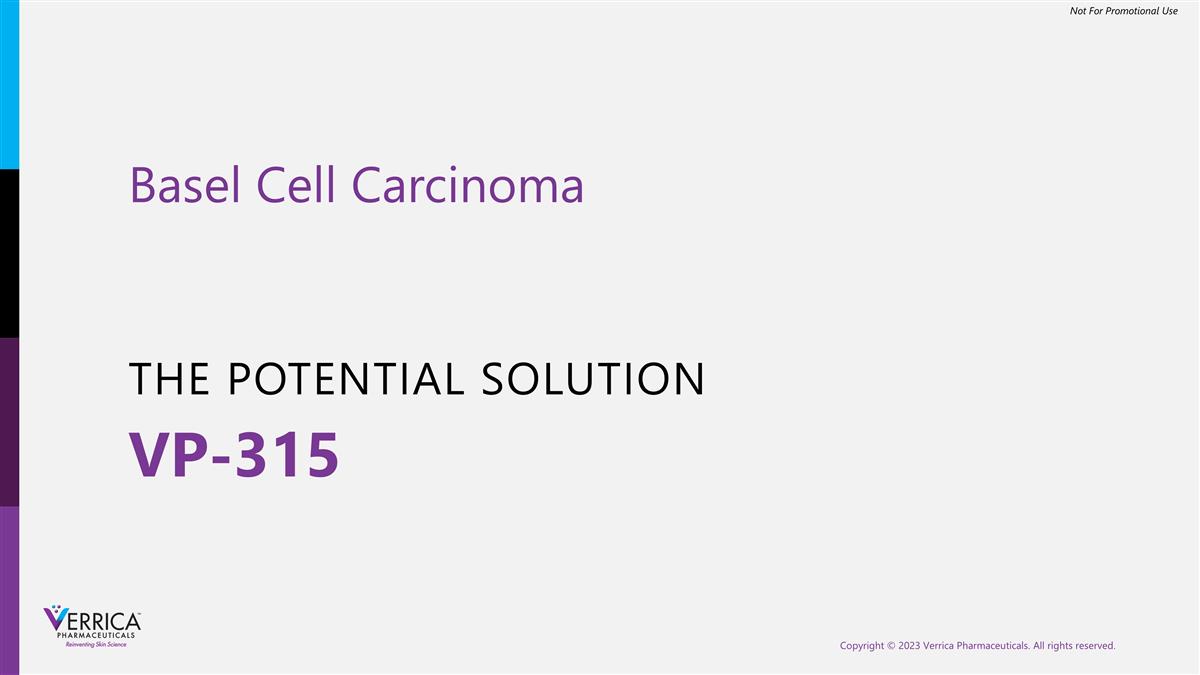
Basel Cell Carcinoma THE POTENTIAL
SOLUTION VP-315
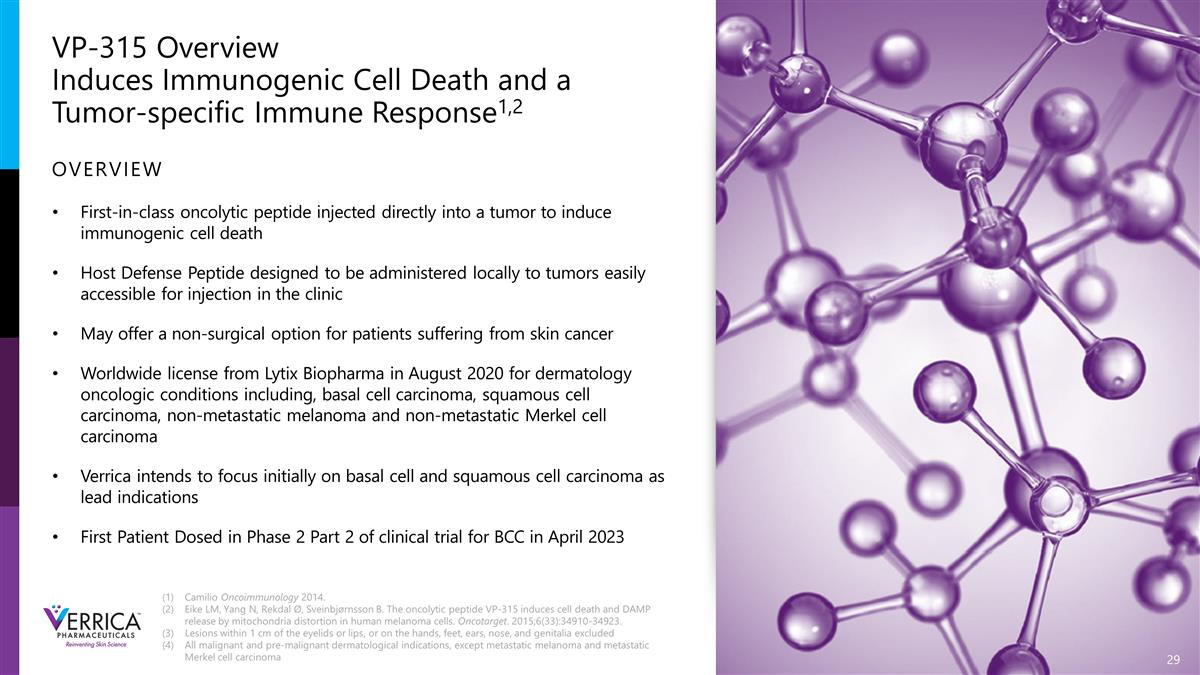
VP-315 Overview Induces Immunogenic
Cell Death and a Tumor-specific Immune Response1,2 First-in-class oncolytic peptide injected directly into a tumor to induce immunogenic cell death Host Defense Peptide designed to be administered locally to tumors easily accessible for injection in
the clinic May offer a non-surgical option for patients suffering from skin cancer Worldwide license from Lytix Biopharma in August 2020 for dermatology oncologic conditions including, basal cell carcinoma, squamous cell carcinoma, non-metastatic
melanoma and non-metastatic Merkel cell carcinoma Verrica intends to focus initially on basal cell and squamous cell carcinoma as lead indications First Patient Dosed in Phase 2 Part 2 of clinical trial for BCC in April 2023 Camilio Oncoimmunology
2014. Eike LM, Yang N, Rekdal Ø, Sveinbjørnsson B. The oncolytic peptide VP-315 induces cell death and DAMP release by mitochondria distortion in human melanoma cells. Oncotarget. 2015;6(33):34910-34923. (3) Lesions within 1 cm
of the eyelids or lips, or on the hands, feet, ears, nose, and genitalia excluded All malignant and pre-malignant dermatological indications, except metastatic melanoma and metastatic Merkel cell carcinoma OVERVIEW
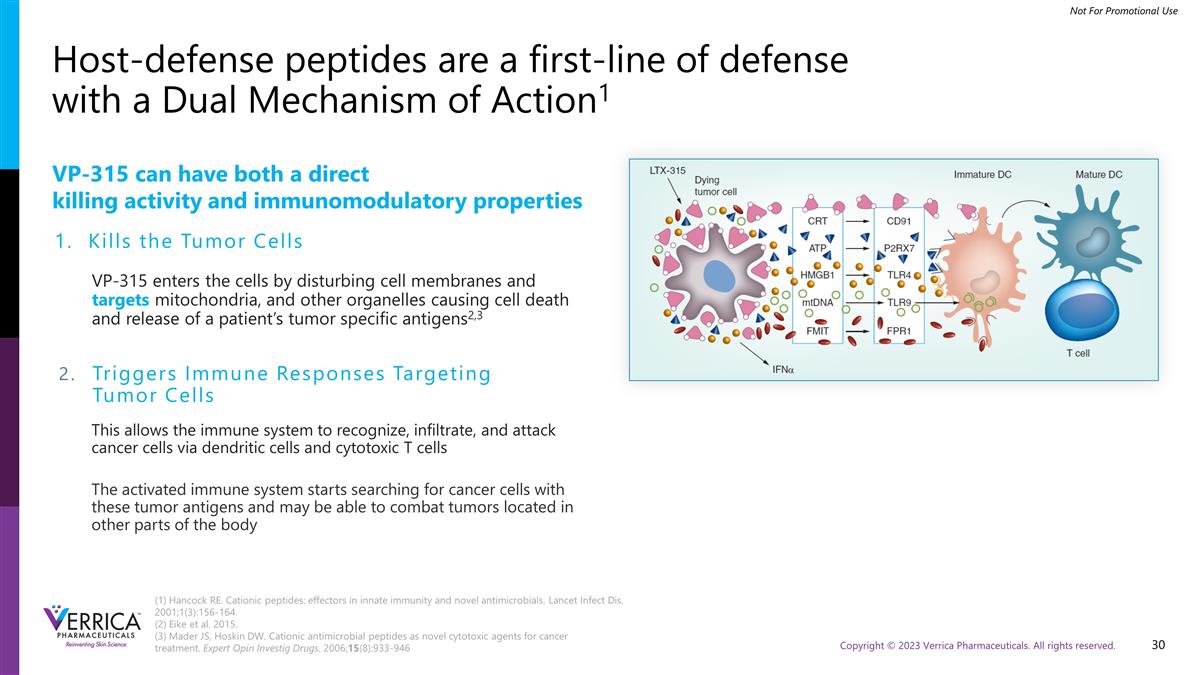
Host-defense peptides are a
first-line of defense with a Dual Mechanism of Action1 VP-315 can have both a direct killing activity and immunomodulatory properties (1) Hancock RE. Cationic peptides: effectors in innate immunity and novel antimicrobials. Lancet Infect Dis.
2001;1(3):156-164. (2) Eike et al. 2015. (3) Mader JS, Hoskin DW. Cationic antimicrobial peptides as novel cytotoxic agents for cancer treatment. Expert Opin Investig Drugs. 2006;15(8):933-946 This allows the immune system to
recognize, infiltrate, and attack cancer cells via dendritic cells and cytotoxic T cells The activated immune system starts searching for cancer cells with these tumor antigens and may be able to combat tumors located in other parts of the body
Triggers Immune Responses Targeting Tumor Cells Kills the Tumor Cells VP-315 enters the cells by disturbing cell membranes and targets mitochondria, and other organelles causing cell death and release of a patient’s tumor specific
antigens2,3
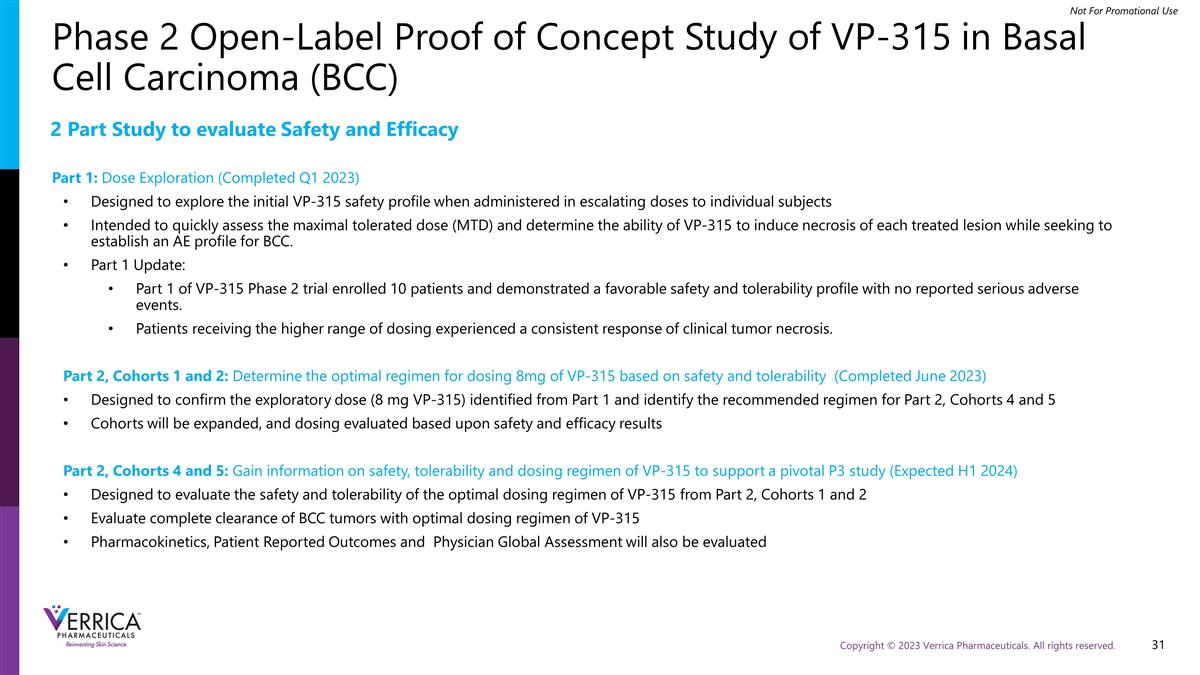
Phase 2 Open-Label Proof of Concept
Study of VP-315 in Basal Cell Carcinoma (BCC) 2 Part Study to evaluate Safety and Efficacy Part 1: Dose Exploration (Completed Q1 2023) Designed to explore the initial VP-315 safety profile when administered in escalating doses to individual
subjects Intended to quickly assess the maximal tolerated dose (MTD) and determine the ability of VP-315 to induce necrosis of each treated lesion while seeking to establish an AE profile for BCC. Part 1 Update: Part 1 of VP-315 Phase 2 trial
enrolled 10 patients and demonstrated a favorable safety and tolerability profile with no reported serious adverse events. Patients receiving the higher range of dosing experienced a consistent response of clinical tumor necrosis. Part 2, Cohorts 1
and 2: Determine the optimal regimen for dosing 8mg of VP-315 based on safety and tolerability (Completed June 2023) Designed to confirm the exploratory dose (8 mg VP-315) identified from Part 1 and identify the recommended regimen for Part 2,
Cohorts 4 and 5 Cohorts will be expanded, and dosing evaluated based upon safety and efficacy results Part 2, Cohorts 4 and 5: Gain information on safety, tolerability and dosing regimen of VP-315 to support a pivotal P3 study (Expected H1 2024)
Designed to evaluate the safety and tolerability of the optimal dosing regimen of VP-315 from Part 2, Cohorts 1 and 2 Evaluate complete clearance of BCC tumors with optimal dosing regimen of VP-315 Pharmacokinetics, Patient Reported Outcomes and
Physician Global Assessment will also be evaluated
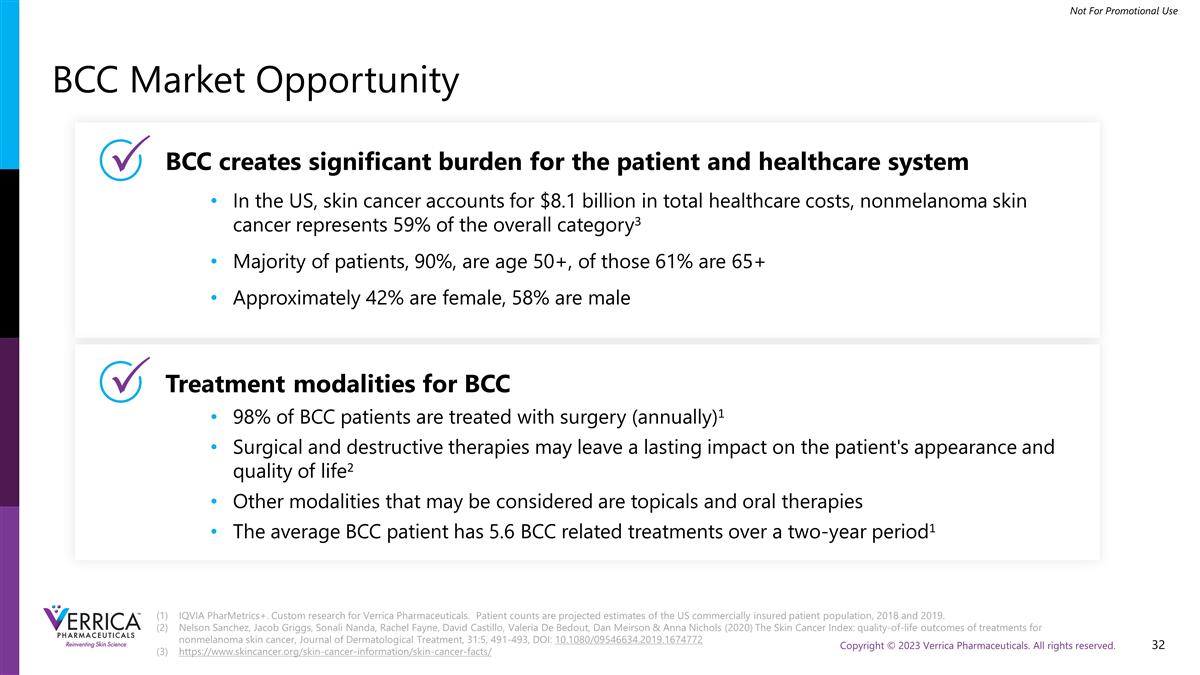
BCC Market Opportunity BCC creates
significant burden for the patient and healthcare system In the US, skin cancer accounts for $8.1 billion in total healthcare costs, nonmelanoma skin cancer represents 59% of the overall category3 Majority of patients, 90%, are age 50+, of those 61%
are 65+ Approximately 42% are female, 58% are male IQVIA PharMetrics+. Custom research for Verrica Pharmaceuticals. Patient counts are projected estimates of the US commercially insured patient population, 2018 and 2019. Nelson Sanchez, Jacob
Griggs, Sonali Nanda, Rachel Fayne, David Castillo, Valeria De Bedout, Dan Meirson & Anna Nichols (2020) The Skin Cancer Index: quality-of-life outcomes of treatments for nonmelanoma skin cancer, Journal of Dermatological
Treatment, 31:5, 491-493, DOI: 10.1080/09546634.2019.1674772 https://www.skincancer.org/skin-cancer-information/skin-cancer-facts/ Treatment modalities for BCC 98% of BCC patients are treated with surgery (annually)1 Surgical and
destructive therapies may leave a lasting impact on the patient's appearance and quality of life2 Other modalities that may be considered are topicals and oral therapies The average BCC patient has 5.6 BCC related treatments over a two-year period1
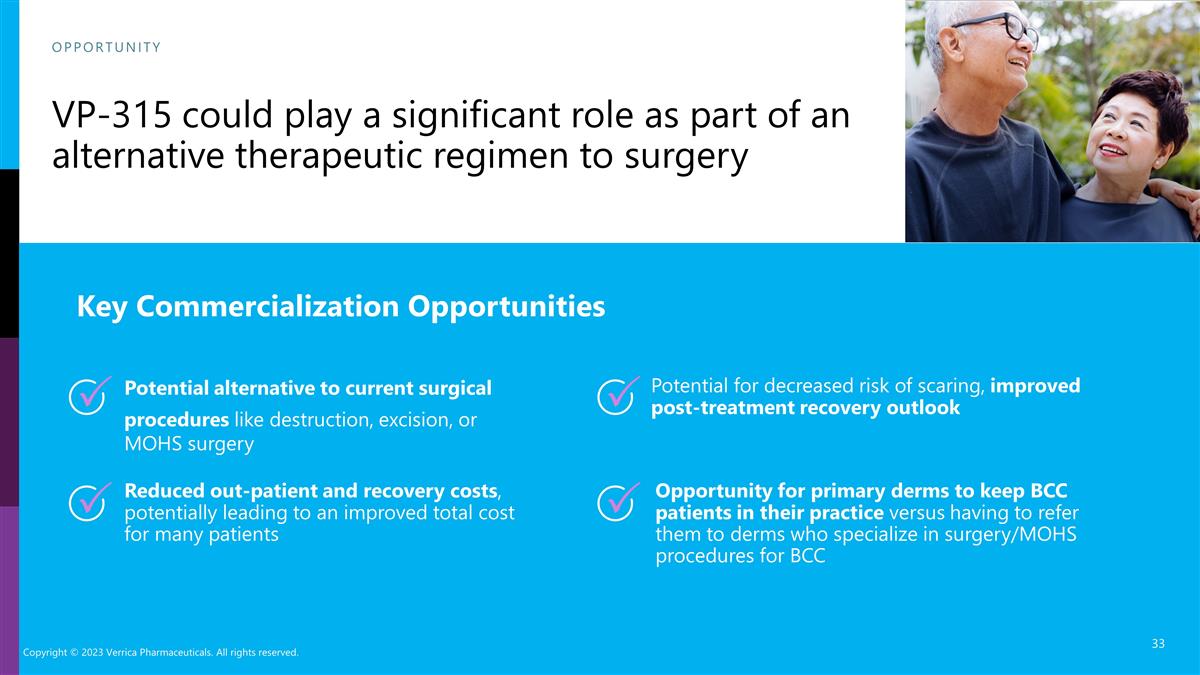
VP-315 could play a significant
role as part of an alternative therapeutic regimen to surgery Potential alternative to current surgical procedures like destruction, excision, or MOHS surgery Reduced out-patient and recovery costs, potentially leading to an improved total cost for
many patients Potential for decreased risk of scaring, improved post-treatment recovery outlook Key Commercialization Opportunities OPPORTUNITY Opportunity for primary derms to keep BCC patients in their practice versus having to refer them to derms
who specialize in surgery/MOHS procedures for BCC Copyright © 2023 Verrica Pharmaceuticals. All rights reserved.
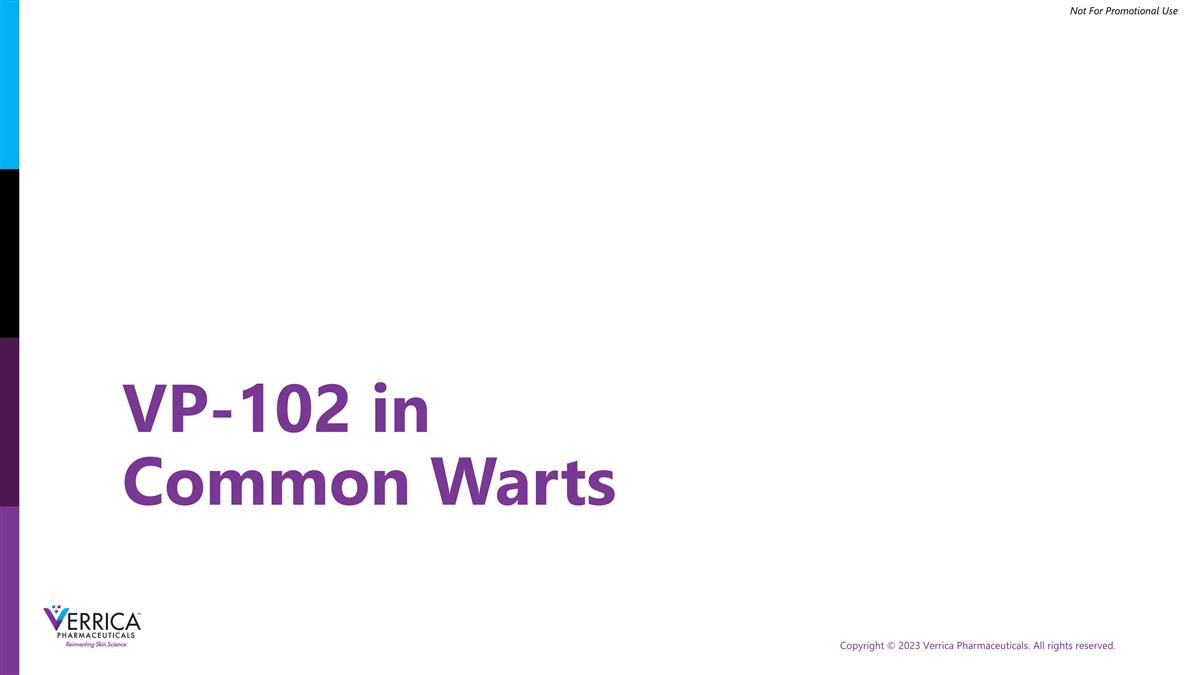
VP-102 in Common Warts
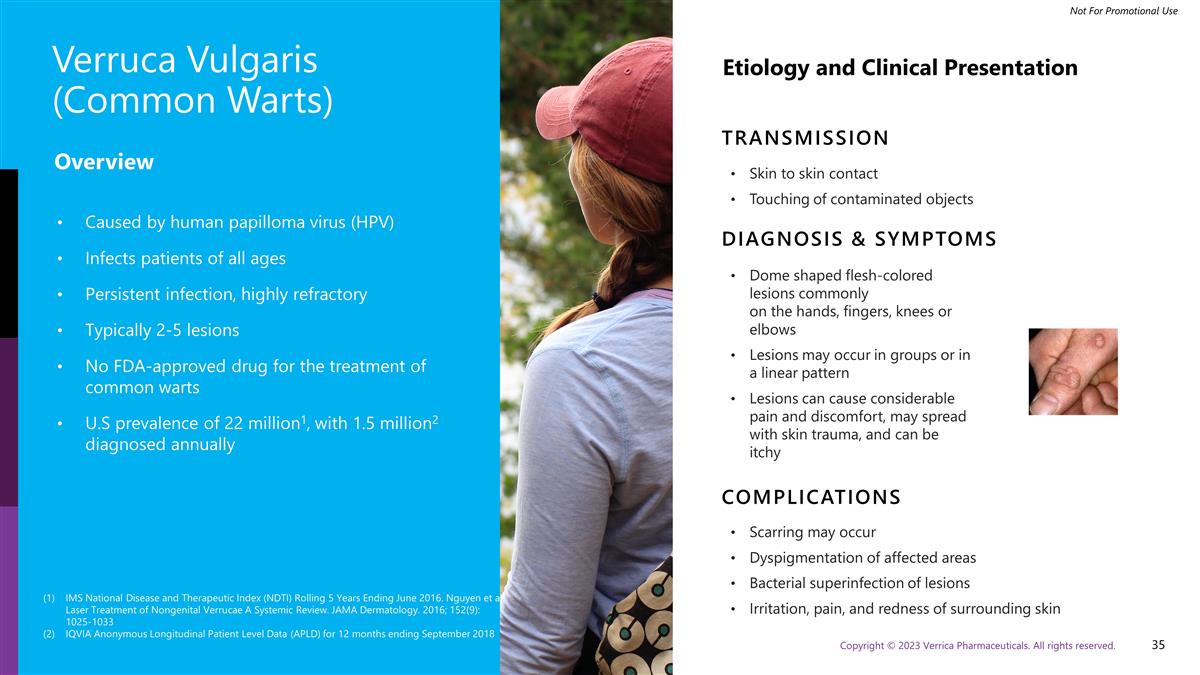
Verruca Vulgaris (Common Warts)
Overview Caused by human papilloma virus (HPV) Infects patients of all ages Persistent infection, highly refractory Typically 2-5 lesions No FDA-approved drug for the treatment of common warts U.S prevalence of 22 million1, with 1.5 million2
diagnosed annually Etiology and Clinical Presentation TRANSMISSION Skin to skin contact Touching of contaminated objects DIAGNOSIS & SYMPTOMS Dome shaped flesh-colored lesions commonly on the hands, fingers, knees or elbows Lesions may occur in
groups or in a linear pattern Lesions can cause considerable pain and discomfort, may spread with skin trauma, and can be itchy COMPLICATIONS Scarring may occur Dyspigmentation of affected areas Bacterial superinfection of lesions Irritation, pain,
and redness of surrounding skin IMS National Disease and Therapeutic Index (NDTI) Rolling 5 Years Ending June 2016. Nguyen et al, Laser Treatment of Nongenital Verrucae A Systemic Review. JAMA Dermatology. 2016; 152(9): 1025-1033 IQVIA Anonymous
Longitudinal Patient Level Data (APLD) for 12 months ending September 2018
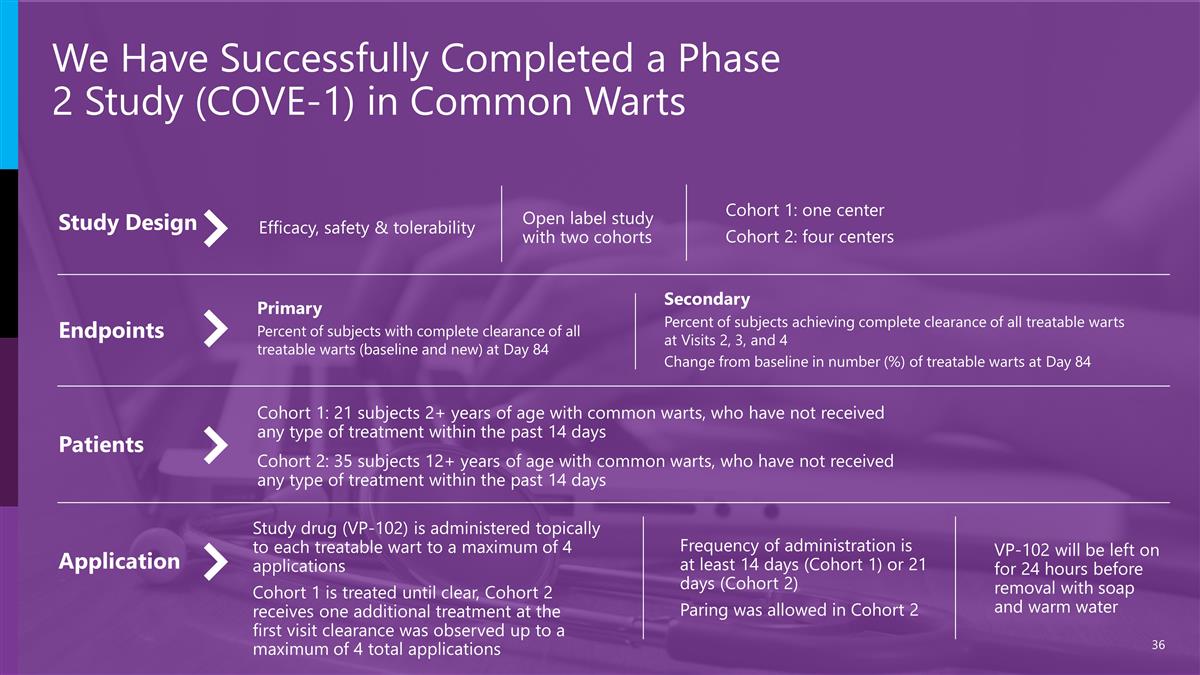
We Have Successfully Completed a
Phase 2 Study (COVE-1) in Common Warts Patients Study Design Endpoints Application Cohort 1: one center Cohort 2: four centers Efficacy, safety & tolerability Open label study with two cohorts Primary Percent of subjects with complete clearance
of all treatable warts (baseline and new) at Day 84 Secondary Percent of subjects achieving complete clearance of all treatable warts at Visits 2, 3, and 4 Change from baseline in number (%) of treatable warts at Day 84 Cohort 1: 21 subjects 2+
years of age with common warts, who have not received any type of treatment within the past 14 days Cohort 2: 35 subjects 12+ years of age with common warts, who have not received any type of treatment within the past 14 days Study drug (VP-102) is
administered topically to each treatable wart to a maximum of 4 applications Cohort 1 is treated until clear, Cohort 2 receives one additional treatment at the first visit clearance was observed up to a maximum of 4 total applications Frequency of
administration is at least 14 days (Cohort 1) or 21 days (Cohort 2) Paring was allowed in Cohort 2 VP-102 will be left on for 24 hours before removal with soap and warm water
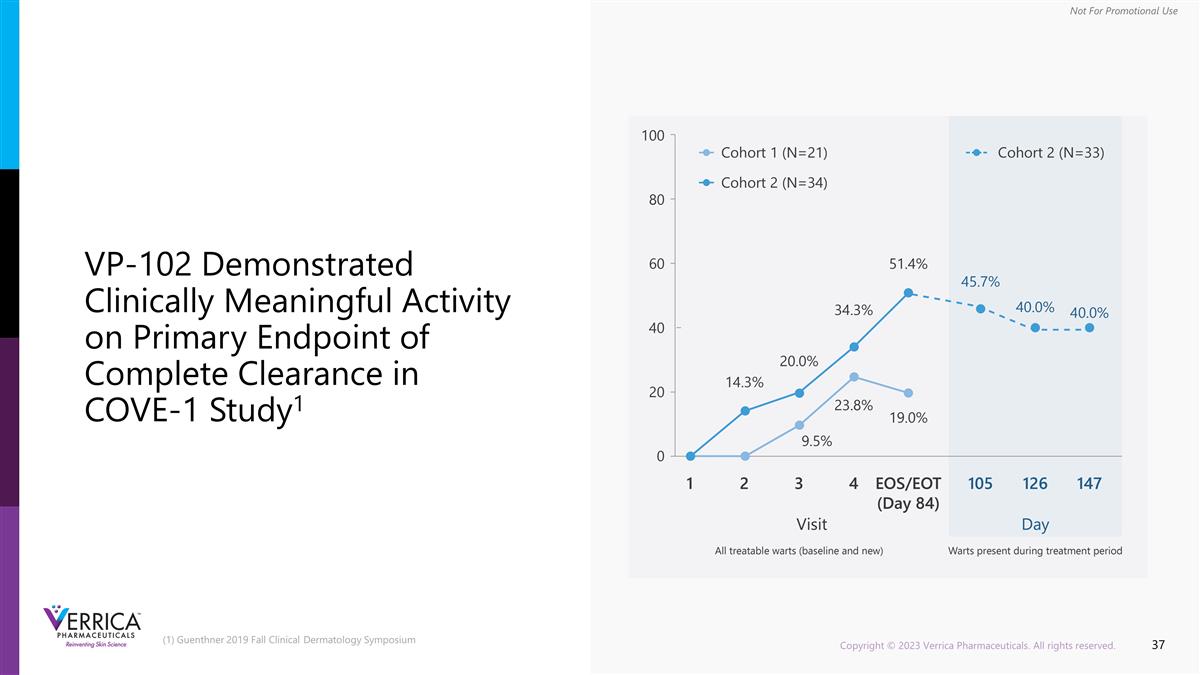
VP-102 Demonstrated Clinically
Meaningful Activity on Primary Endpoint of Complete Clearance in COVE-1 Study1 (1) Guenthner 2019 Fall Clinical Dermatology Symposium
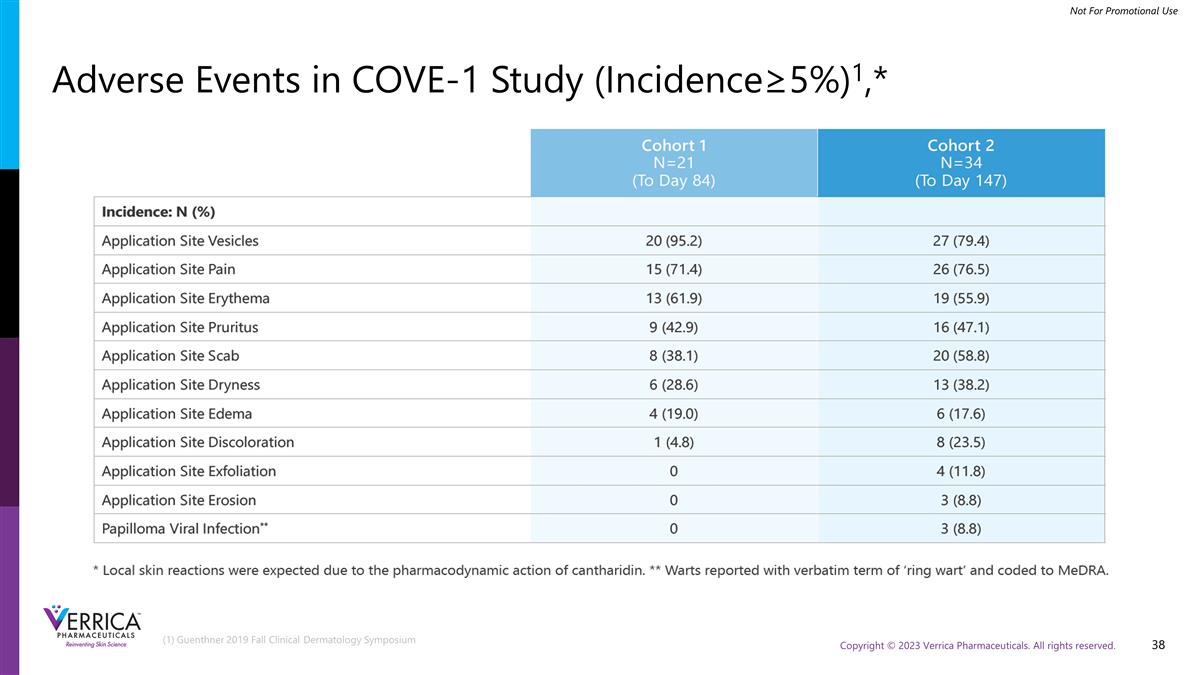
Adverse Events in COVE-1 Study
(Incidence≥5%)1,* (1) Guenthner 2019 Fall Clinical Dermatology Symposium

VP-102 in External Genital
Warts
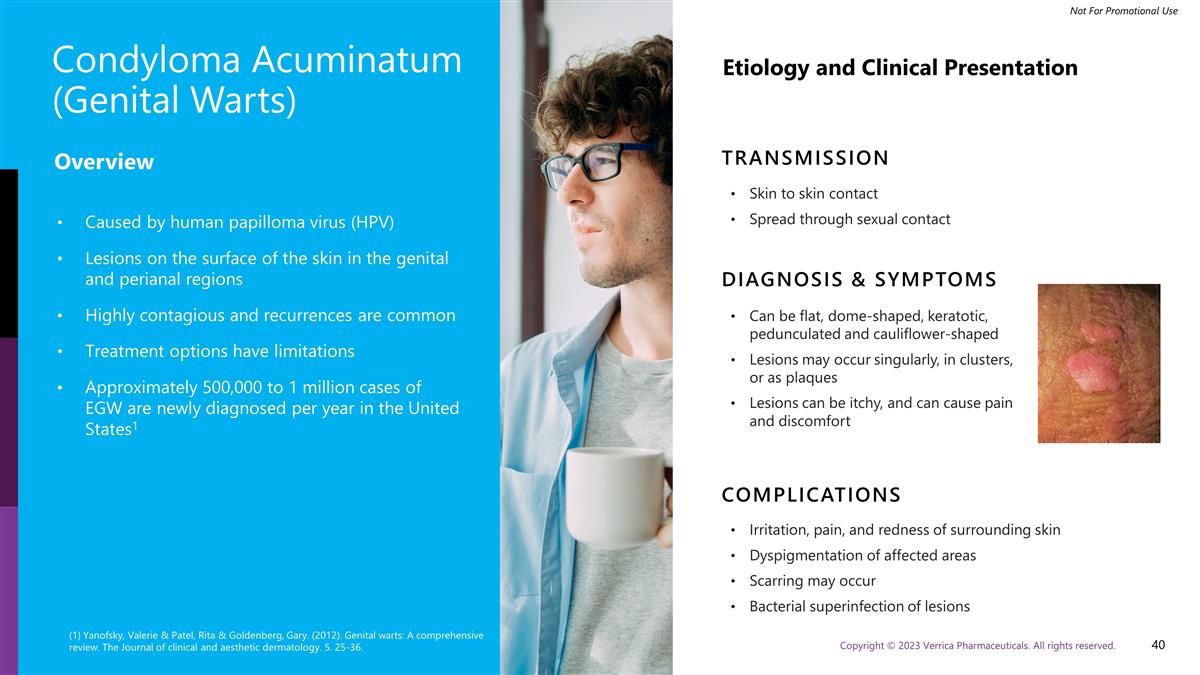
Condyloma Acuminatum (Genital
Warts) Overview Caused by human papilloma virus (HPV) Lesions on the surface of the skin in the genital and perianal regions Highly contagious and recurrences are common Treatment options have limitations Approximately 500,000 to 1 million cases of
EGW are newly diagnosed per year in the United States1 Etiology and Clinical Presentation TRANSMISSION Skin to skin contact Spread through sexual contact DIAGNOSIS & SYMPTOMS Can be flat, dome-shaped, keratotic, pedunculated and
cauliflower-shaped Lesions may occur singularly, in clusters, or as plaques Lesions can be itchy, and can cause pain and discomfort COMPLICATIONS Irritation, pain, and redness of surrounding skin Dyspigmentation of affected areas Scarring may occur
Bacterial superinfection of lesions (1) Yanofsky, Valerie & Patel, Rita & Goldenberg, Gary. (2012). Genital warts: A comprehensive review. The Journal of clinical and aesthetic dermatology. 5. 25-36.
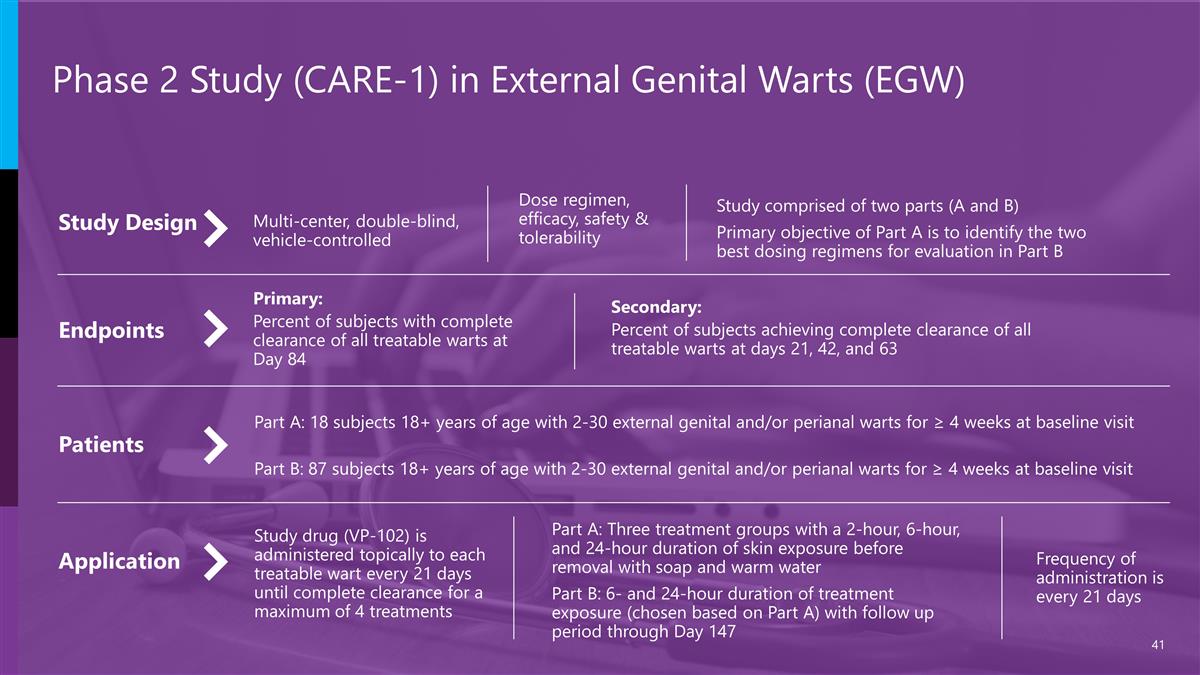
Phase 2 Study (CARE-1) in External
Genital Warts (EGW) Patients Study Design Endpoints Application Primary: Percent of subjects with complete clearance of all treatable warts at Day 84 Secondary: Percent of subjects achieving complete clearance of all treatable warts at days 21, 42,
and 63 Multi-center, double-blind, vehicle-controlled Dose regimen, efficacy, safety & tolerability Study comprised of two parts (A and B) Primary objective of Part A is to identify the two best dosing regimens for evaluation in Part B Part A:
18 subjects 18+ years of age with 2-30 external genital and/or perianal warts for ≥ 4 weeks at baseline visit Part B: 87 subjects 18+ years of age with 2-30 external genital and/or perianal warts for ≥ 4 weeks at baseline visit Frequency
of administration is every 21 days Study drug (VP-102) is administered topically to each treatable wart every 21 days until complete clearance for a maximum of 4 treatments Part A: Three treatment groups with a 2-hour, 6-hour, and 24-hour duration
of skin exposure before removal with soap and warm water Part B: 6- and 24-hour duration of treatment exposure (chosen based on Part A) with follow up period through Day 147
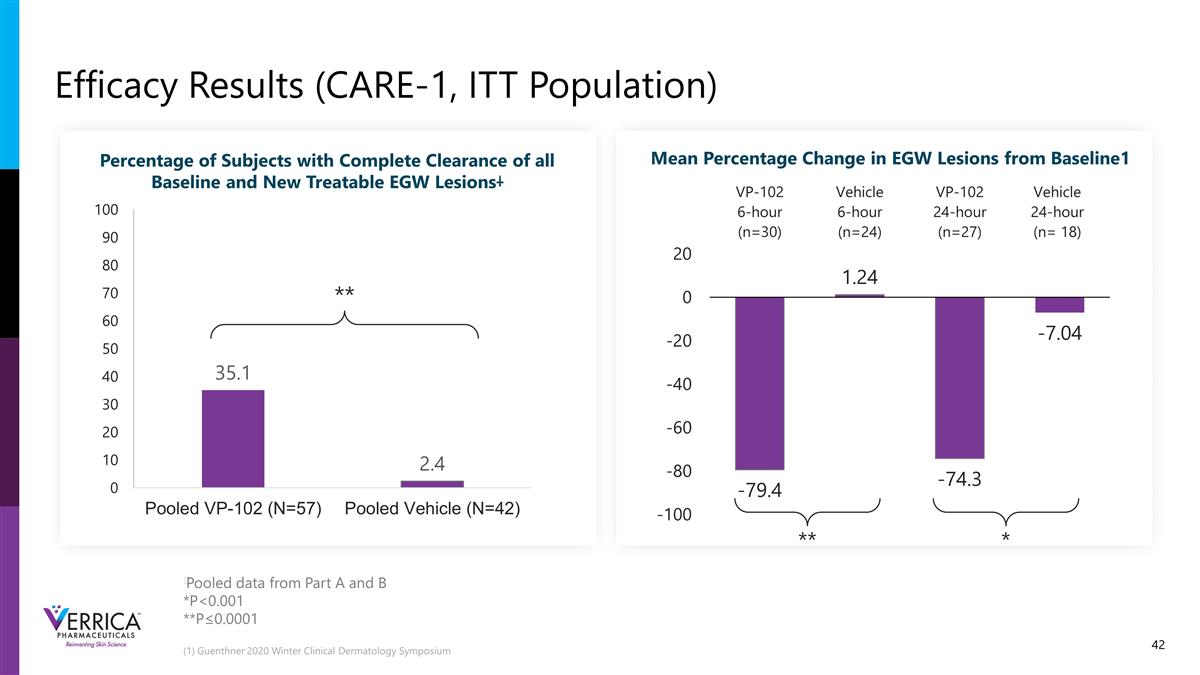
Efficacy Results (CARE-1, ITT
Population) Pooled data from Part A and B *P<0.001 **P≤0.0001 ** ** (1) Guenthner 2020 Winter Clinical Dermatology Symposium Mean Percentage Change in EGW Lesions from Baseline1 Percentage of Subjects with Complete Clearance of all Baseline
and New Treatable EGW Lesions⸸ *
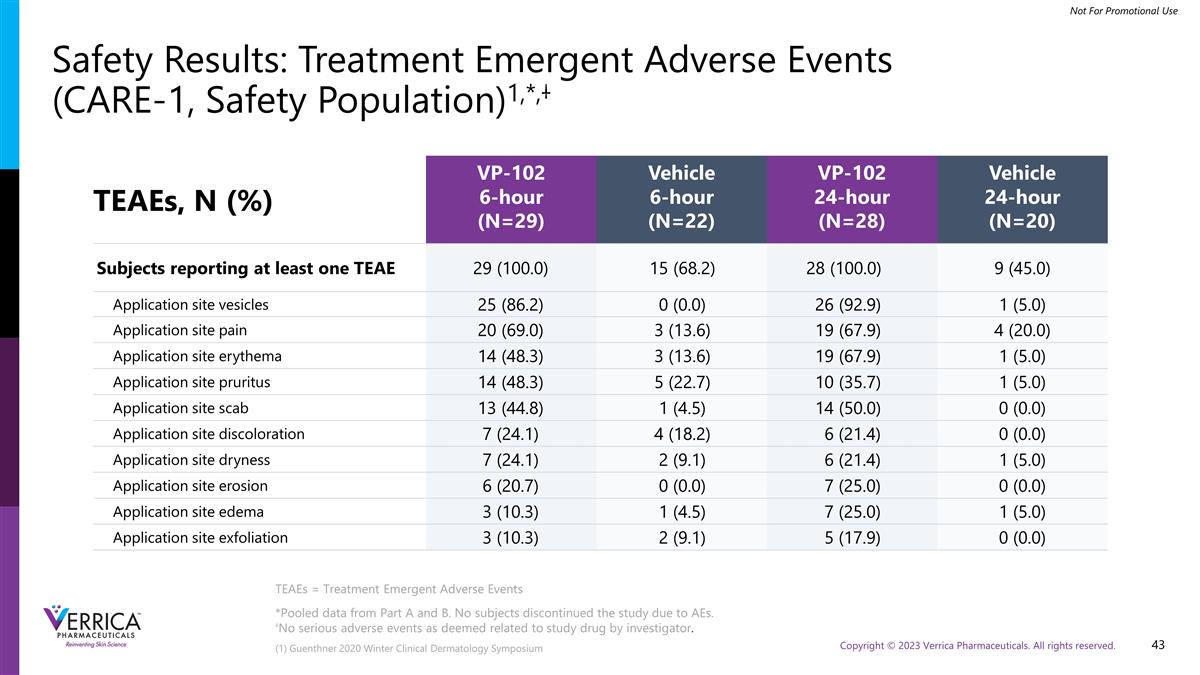
Safety Results: Treatment Emergent
Adverse Events (CARE-1, Safety Population)1,*,⸸ TEAEs, N (%) VP-102 6-hour (N=29) Vehicle 6-hour (N=22) VP-102 24-hour (N=28) Vehicle 24-hour (N=20) Subjects reporting at least one TEAE 29 (100.0) 15 (68.2) 28 (100.0) 9 (45.0) Application
site vesicles 25 (86.2) 0 (0.0) 26 (92.9) 1 (5.0) Application site pain 20 (69.0) 3 (13.6) 19 (67.9) 4 (20.0) Application site erythema 14 (48.3) 3 (13.6) 19 (67.9) 1 (5.0) Application site pruritus 14 (48.3) 5 (22.7) 10 (35.7) 1 (5.0) Application
site scab 13 (44.8) 1 (4.5) 14 (50.0) 0 (0.0) Application site discoloration 7 (24.1) 4 (18.2) 6 (21.4) 0 (0.0) Application site dryness 7 (24.1) 2 (9.1) 6 (21.4) 1 (5.0) Application site erosion 6 (20.7) 0 (0.0) 7 (25.0) 0 (0.0) Application site
edema 3 (10.3) 1 (4.5) 7 (25.0) 1 (5.0) Application site exfoliation 3 (10.3) 2 (9.1) 5 (17.9) 0 (0.0) TEAEs = Treatment Emergent Adverse Events *Pooled data from Part A and B. No subjects discontinued the study due to AEs. No serious adverse events
as deemed related to study drug by investigator. (1) Guenthner 2020 Winter Clinical Dermatology Symposium
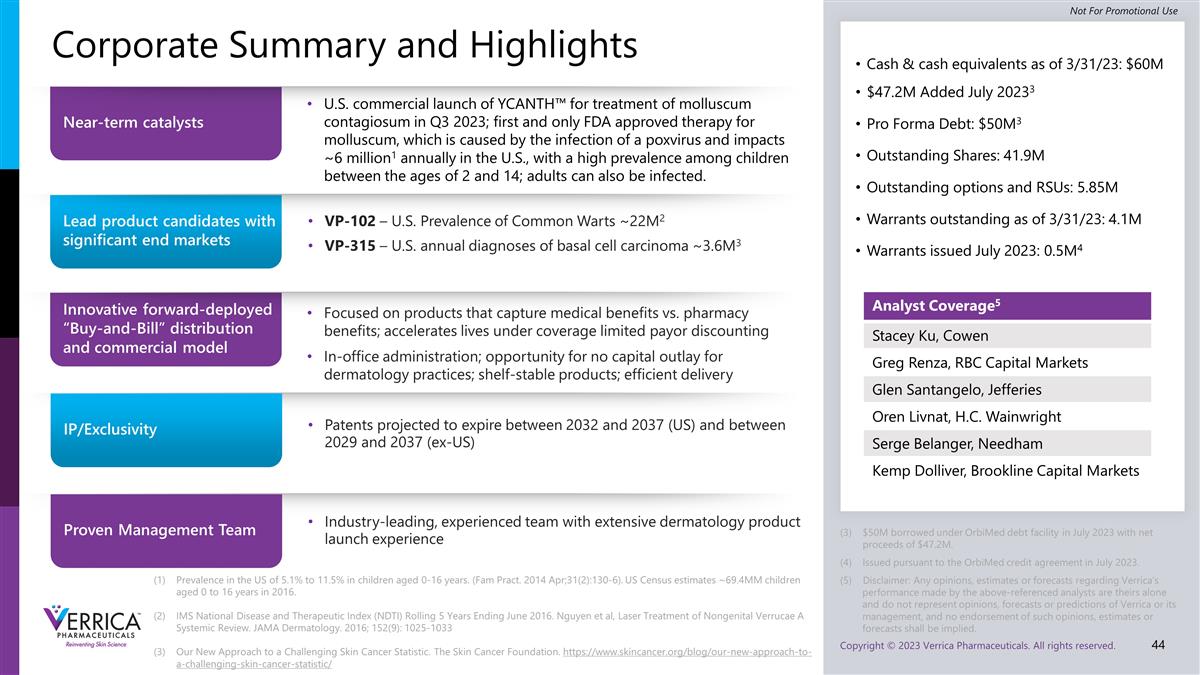
Corporate Summary and Highlights
Analyst Coverage5 Stacey Ku, Cowen Greg Renza, RBC Capital Markets Glen Santangelo, Jefferies Oren Livnat, H.C. Wainwright Serge Belanger, Needham Kemp Dolliver, Brookline Capital Markets Cash & cash equivalents as of 3/31/23: $60M $47.2M Added
July 20233 Pro Forma Debt: $50M3 Outstanding Shares: 41.9M Outstanding options and RSUs: 5.85M Warrants outstanding as of 3/31/23: 4.1M Warrants issued July 2023: 0.5M4 Near-term catalysts U.S. commercial launch of YCANTH™ for treatment of
molluscum contagiosum in Q3 2023; first and only FDA approved therapy for molluscum, which is caused by the infection of a poxvirus and impacts ~6 million1 annually in the U.S., with a high prevalence among children between the ages of 2 and 14;
adults can also be infected. Lead product candidates with significant end markets VP-102 – U.S. Prevalence of Common Warts ~22M2 VP-315 – U.S. annual diagnoses of basal cell carcinoma ~3.6M3 Innovative forward-deployed
“Buy-and-Bill” distribution and commercial model Focused on products that capture medical benefits vs. pharmacy benefits; accelerates lives under coverage limited payor discounting In-office administration; opportunity for no capital
outlay for dermatology practices; shelf-stable products; efficient delivery Patents projected to expire between 2032 and 2037 (US) and between 2029 and 2037 (ex-US) Industry-leading, experienced team with extensive dermatology product launch
experience Prevalence in the US of 5.1% to 11.5% in children aged 0-16 years. (Fam Pract. 2014 Apr;31(2):130-6). US Census estimates ~69.4MM children aged 0 to 16 years in 2016. IMS National Disease and Therapeutic Index (NDTI) Rolling 5 Years
Ending June 2016. Nguyen et al, Laser Treatment of Nongenital Verrucae A Systemic Review. JAMA Dermatology. 2016; 152(9): 1025-1033 Our New Approach to a Challenging Skin Cancer Statistic. The Skin Cancer
Foundation. https://www.skincancer.org/blog/our-new-approach-to-a-challenging-skin-cancer-statistic/ IP/Exclusivity Proven Management Team $50M borrowed under OrbiMed debt facility in July 2023 with net proceeds of $47.2M. Issued pursuant to
the OrbiMed credit agreement in July 2023. (5) Disclaimer: Any opinions, estimates or forecasts regarding Verricaʼs performance made by the above-referenced analysts are theirs alone and do not represent opinions, forecasts or predictions of
Verrica or its management, and no endorsement of such opinions, estimates or forecasts shall be implied.

Appendix
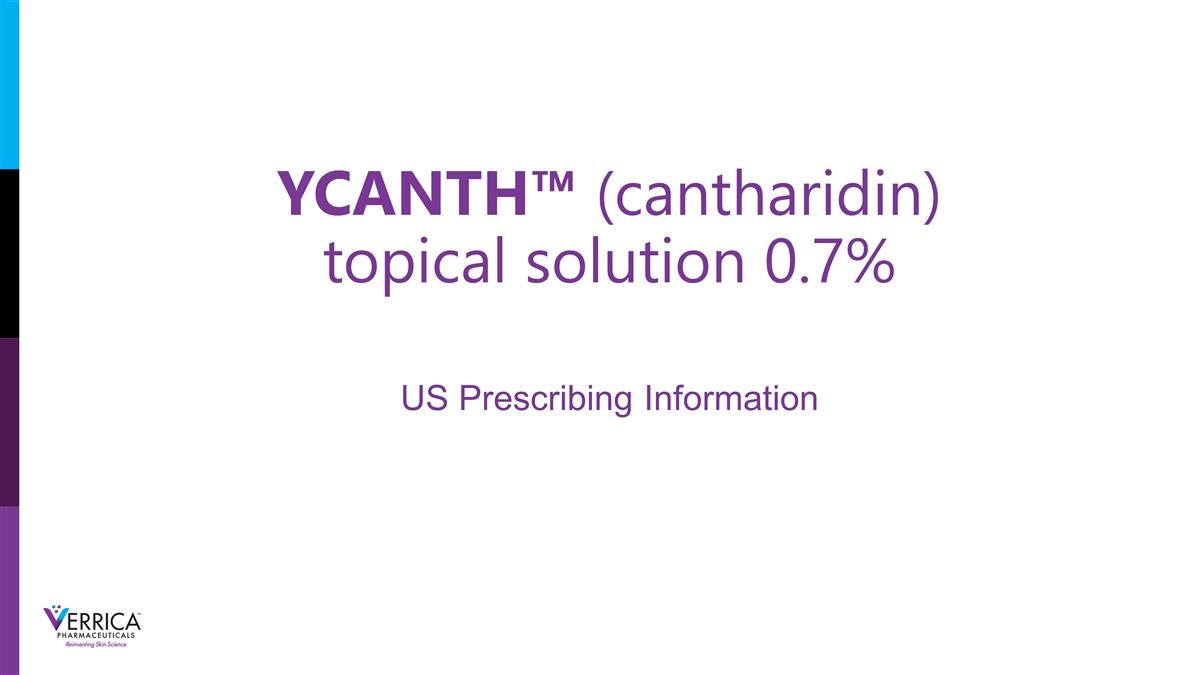
YCANTH™ (cantharidin) topical
solution 0.7% US Prescribing Information
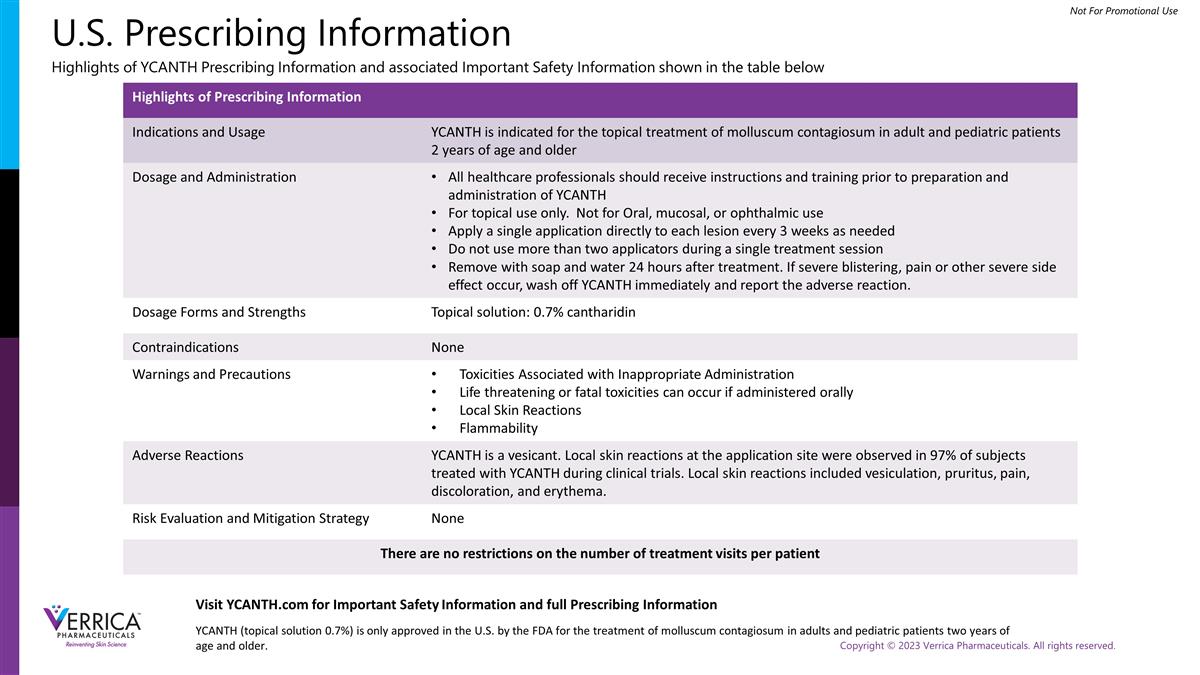
U.S. Prescribing Information
Highlights of YCANTH Prescribing Information and associated Important Safety Information shown in the table below Highlights of Prescribing Information Indications and Usage YCANTH is indicated for the topical treatment of molluscum contagiosum in
adult and pediatric patients 2 years of age and older Dosage and Administration All healthcare professionals should receive instructions and training prior to preparation and administration of YCANTH For topical use only. Not for Oral, mucosal, or
ophthalmic use Apply a single application directly to each lesion every 3 weeks as needed Do not use more than two applicators during a single treatment session Remove with soap and water 24 hours after treatment. If severe blistering, pain or other
severe side effect occur, wash off YCANTH immediately and report the adverse reaction. Dosage Forms and Strengths Topical solution: 0.7% cantharidin Contraindications None Warnings and Precautions Toxicities Associated with Inappropriate
Administration Life threatening or fatal toxicities can occur if administered orally Local Skin Reactions Flammability Adverse Reactions YCANTH is a vesicant. Local skin reactions at the application site were observed in 97% of subjects
treated with YCANTH during clinical trials. Local skin reactions included vesiculation, pruritus, pain, discoloration, and erythema. Risk Evaluation and Mitigation Strategy None There are no restrictions on the number of treatment visits per
patient Visit YCANTH.com for Important Safety Information and full Prescribing Information YCANTH (topical solution 0.7%) is only approved in the U.S. by the FDA for the treatment of molluscum contagiosum in adults and pediatric patients two years
of age and older.
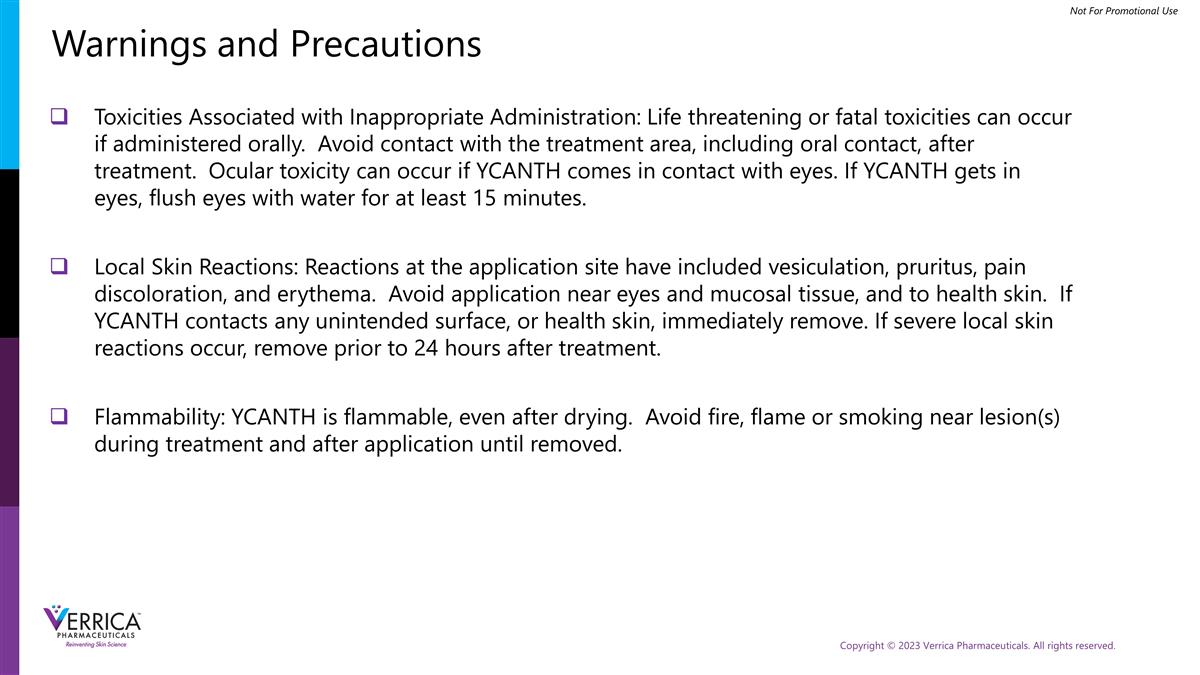
Warnings and Precautions Toxicities
Associated with Inappropriate Administration: Life threatening or fatal toxicities can occur if administered orally. Avoid contact with the treatment area, including oral contact, after treatment. Ocular toxicity can occur if YCANTH comes in contact
with eyes. If YCANTH gets in eyes, flush eyes with water for at least 15 minutes. Local Skin Reactions: Reactions at the application site have included vesiculation, pruritus, pain discoloration, and erythema. Avoid application near eyes and mucosal
tissue, and to health skin. If YCANTH contacts any unintended surface, or health skin, immediately remove. If severe local skin reactions occur, remove prior to 24 hours after treatment. Flammability: YCANTH is flammable, even after drying. Avoid
fire, flame or smoking near lesion(s) during treatment and after application until removed.
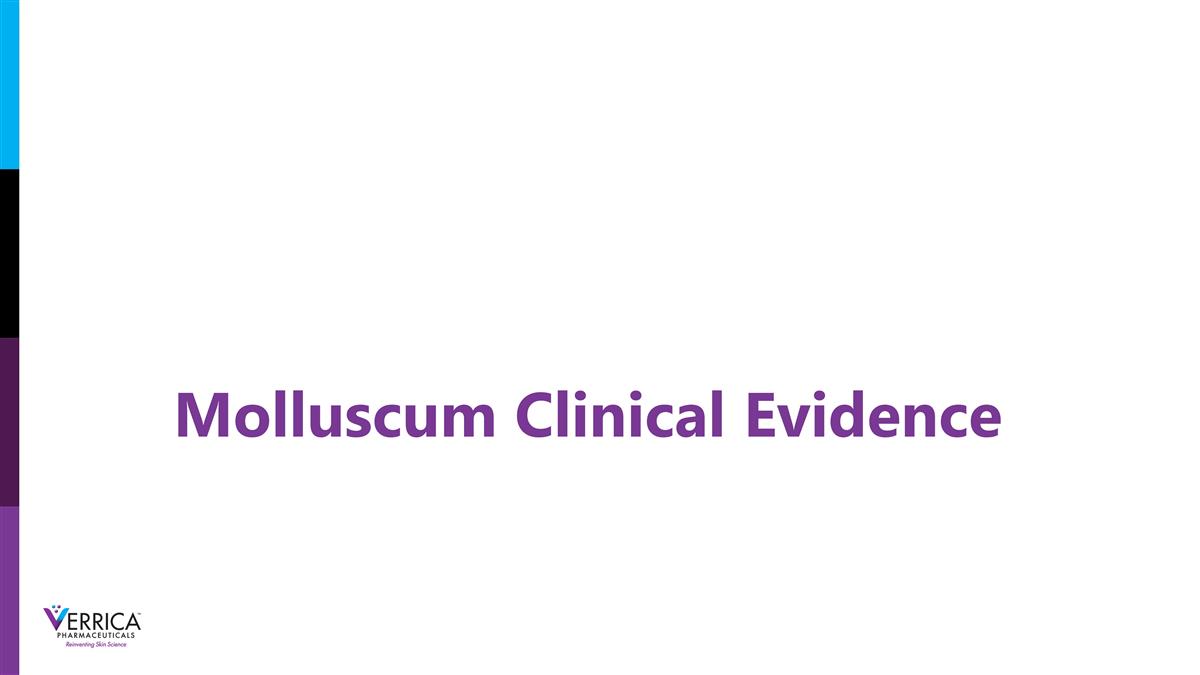
Molluscum Clinical
Evidence
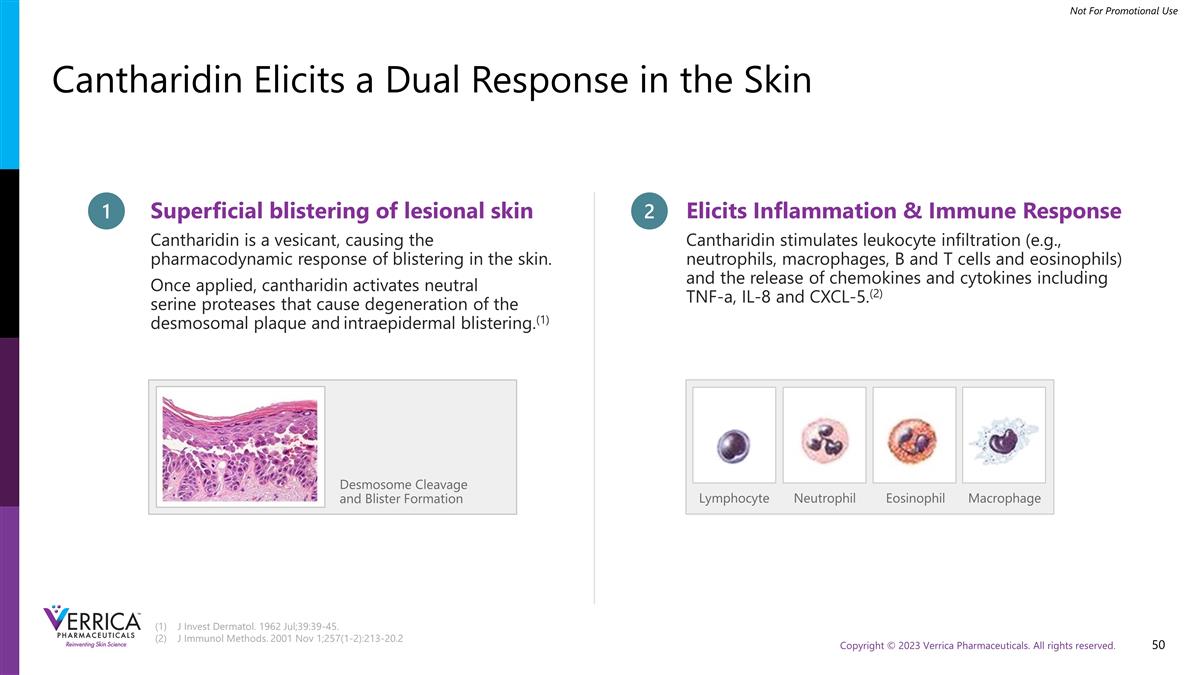
Cantharidin Elicits a Dual Response
in the Skin Superficial blistering of lesional skin Cantharidin is a vesicant, causing the pharmacodynamic response of blistering in the skin. Once applied, cantharidin activates neutral serine proteases that cause degeneration of the desmosomal
plaque and intraepidermal blistering.(1) Elicits Inflammation & Immune Response Cantharidin stimulates leukocyte infiltration (e.g., neutrophils, macrophages, B and T cells and eosinophils) and the release of chemokines and cytokines including
TNF-a, IL-8 and CXCL-5.(2) J Invest Dermatol. 1962 Jul;39:39-45. J Immunol Methods. 2001 Nov 1;257(1-2):213-20.2 Desmosome Cleavage and Blister Formation Lymphocyte Neutrophil Eosinophil Macrophage 1 2
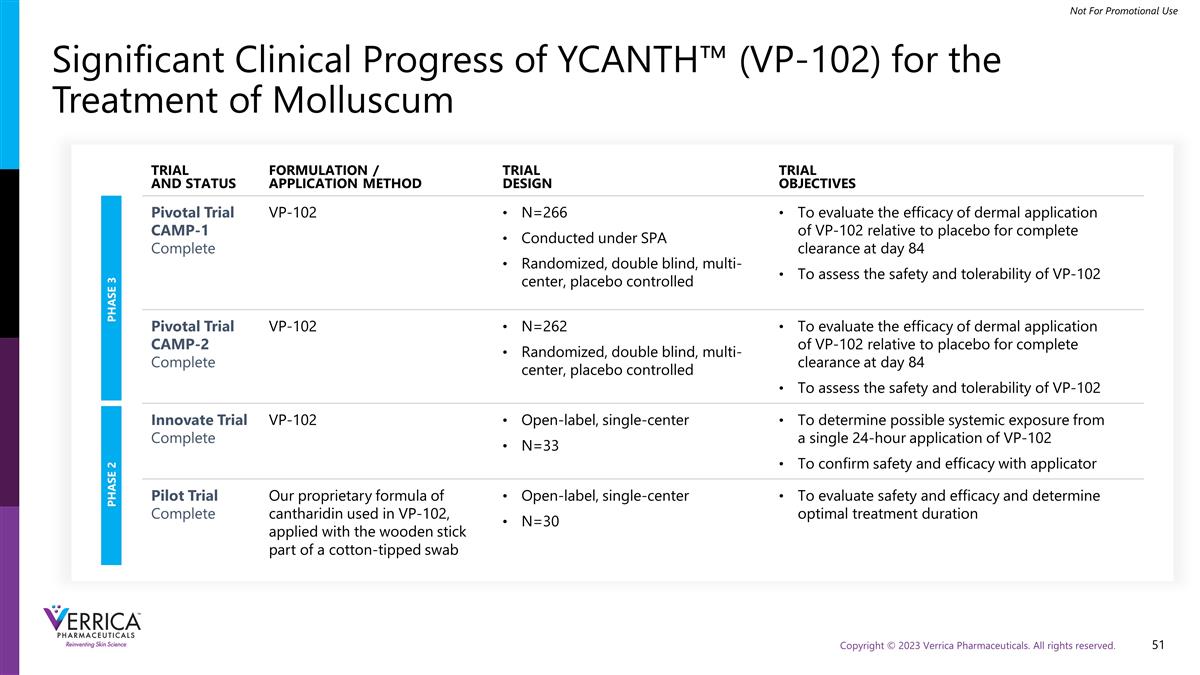
Significant Clinical Progress of
YCANTH™ (VP-102) for the Treatment of Molluscum TRIAL AND STATUS FORMULATION / APPLICATION METHOD TRIAL DESIGN TRIAL OBJECTIVES PHASE 3 Pivotal Trial CAMP-1 Complete VP-102 N=266 Conducted under SPA Randomized, double blind, multi-center,
placebo controlled To evaluate the efficacy of dermal application of VP-102 relative to placebo for complete clearance at day 84 To assess the safety and tolerability of VP-102 Pivotal Trial CAMP-2 Complete VP-102 N=262 Randomized, double blind,
multi-center, placebo controlled To evaluate the efficacy of dermal application of VP-102 relative to placebo for complete clearance at day 84 To assess the safety and tolerability of VP-102 PHASE 2 Innovate Trial Complete VP-102 Open-label,
single-center N=33 To determine possible systemic exposure from a single 24-hour application of VP-102 To confirm safety and efficacy with applicator Pilot Trial Complete Our proprietary formula of cantharidin used in VP-102, applied with the wooden
stick part of a cotton-tipped swab Open-label, single-center N=30 To evaluate safety and efficacy and determine optimal treatment duration
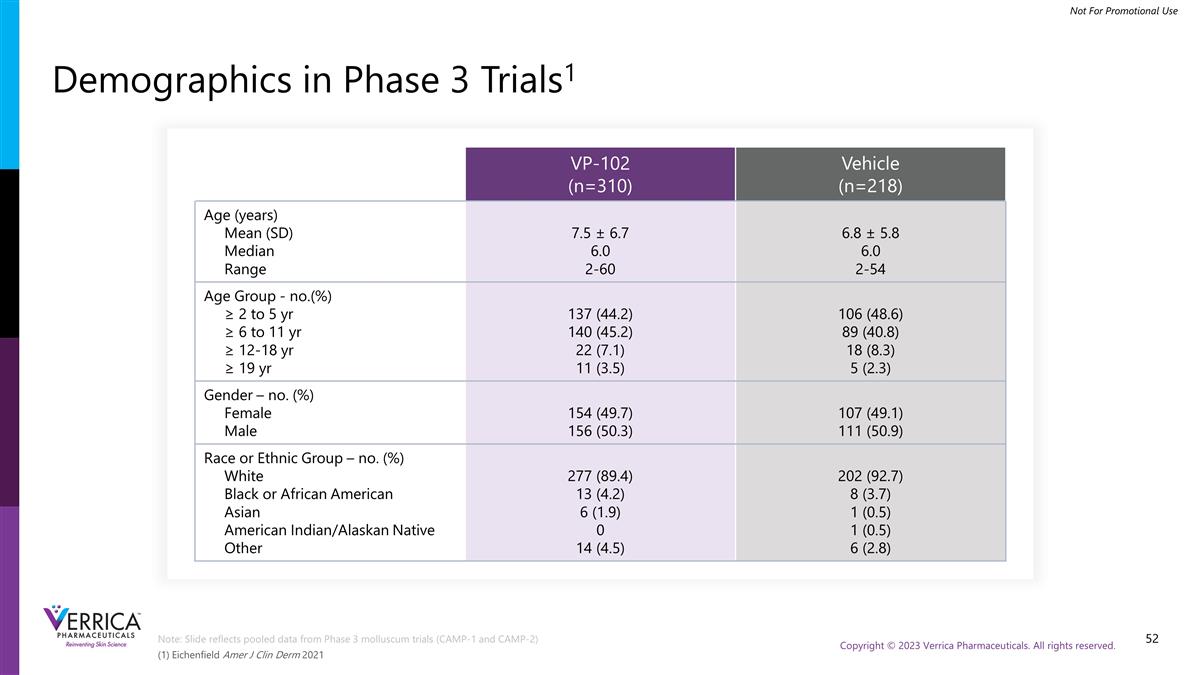
Demographics in Phase 3 Trials1
VP-102 (n=310) Vehicle (n=218) Age (years) Mean (SD) Median Range 7.5 ± 6.7 6.0 2-60 6.8 ± 5.8 6.0 2-54 Age Group - no.(%) ≥ 2 to 5 yr ≥ 6 to 11 yr ≥ 12-18 yr ≥ 19 yr 137 (44.2) 140 (45.2) 22 (7.1) 11 (3.5) 106
(48.6) 89 (40.8) 18 (8.3) 5 (2.3) Gender – no. (%) Female Male 154 (49.7) 156 (50.3) 107 (49.1) 111 (50.9) Race or Ethnic Group – no. (%) White Black or African American Asian American Indian/Alaskan Native Other 277 (89.4) 13 (4.2) 6
(1.9) 0 14 (4.5) 202 (92.7) 8 (3.7) 1 (0.5) 1 (0.5) 6 (2.8) Note: Slide reflects pooled data from Phase 3 molluscum trials (CAMP-1 and CAMP-2) (1) Eichenfield Amer J Clin Derm 2021
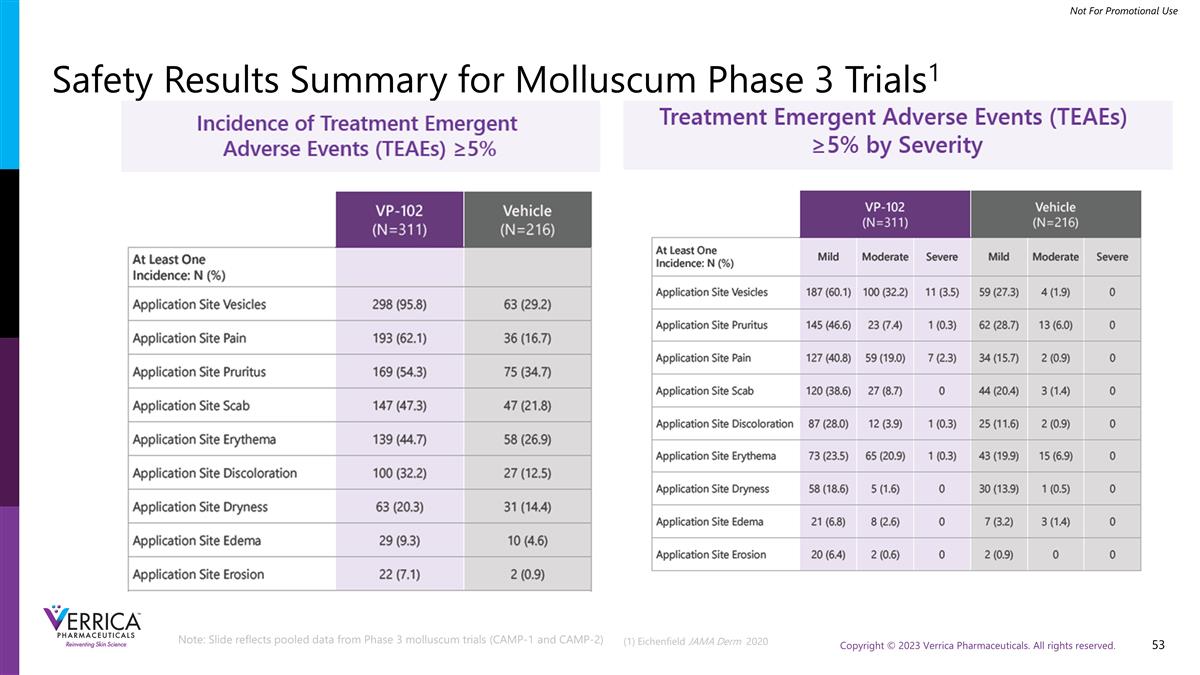
Safety Results Summary for
Molluscum Phase 3 Trials1 Note: Slide reflects pooled data from Phase 3 molluscum trials (CAMP-1 and CAMP-2) (1) Eichenfield JAMA Derm 2020
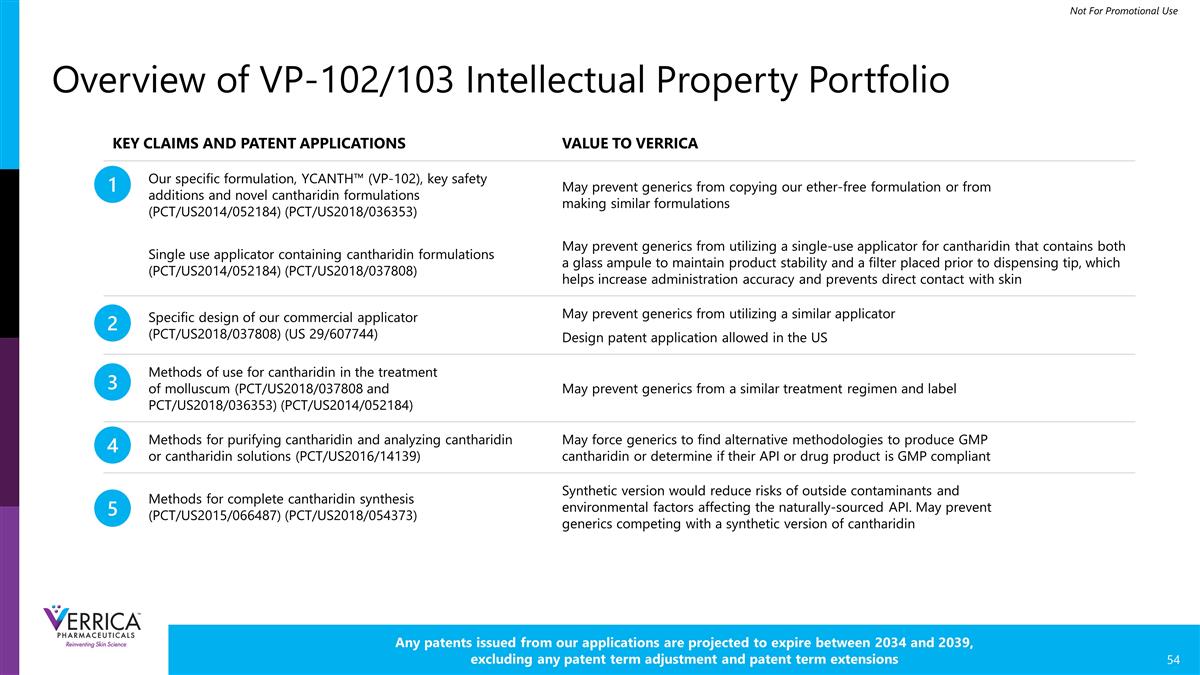
Overview of VP-102/103 Intellectual
Property Portfolio KEY CLAIMS AND PATENT APPLICATIONS VALUE TO VERRICA Our specific formulation, YCANTH™ (VP-102), key safety additions and novel cantharidin formulations (PCT/US2014/052184) (PCT/US2018/036353) May prevent generics from
copying our ether-free formulation or from making similar formulations Single use applicator containing cantharidin formulations (PCT/US2014/052184) (PCT/US2018/037808) May prevent generics from utilizing a single-use applicator for cantharidin that
contains both a glass ampule to maintain product stability and a filter placed prior to dispensing tip, which helps increase administration accuracy and prevents direct contact with skin Specific design of our commercial applicator
(PCT/US2018/037808) (US 29/607744) May prevent generics from utilizing a similar applicator Design patent application allowed in the US Methods of use for cantharidin in the treatment of molluscum (PCT/US2018/037808 and PCT/US2018/036353)
(PCT/US2014/052184) May prevent generics from a similar treatment regimen and label Methods for purifying cantharidin and analyzing cantharidin or cantharidin solutions (PCT/US2016/14139) May force generics to find alternative methodologies to
produce GMP cantharidin or determine if their API or drug product is GMP compliant Methods for complete cantharidin synthesis (PCT/US2015/066487) (PCT/US2018/054373) Synthetic version would reduce risks of outside contaminants and environmental
factors affecting the naturally-sourced API. May prevent generics competing with a synthetic version of cantharidin Any patents issued from our applications are projected to expire between 2034 and 2039, excluding any patent term adjustment and
patent term extensions 1 2 3 4 5
v3.23.2
| X |
- DefinitionBoolean flag that is true when the XBRL content amends previously-filed or accepted submission.
| Name: |
dei_AmendmentFlag |
| Namespace Prefix: |
dei_ |
| Data Type: |
xbrli:booleanItemType |
| Balance Type: |
na |
| Period Type: |
duration |
|
| X |
- DefinitionFor the EDGAR submission types of Form 8-K: the date of the report, the date of the earliest event reported; for the EDGAR submission types of Form N-1A: the filing date; for all other submission types: the end of the reporting or transition period. The format of the date is YYYY-MM-DD.
| Name: |
dei_DocumentPeriodEndDate |
| Namespace Prefix: |
dei_ |
| Data Type: |
xbrli:dateItemType |
| Balance Type: |
na |
| Period Type: |
duration |
|
| X |
- DefinitionThe type of document being provided (such as 10-K, 10-Q, 485BPOS, etc). The document type is limited to the same value as the supporting SEC submission type, or the word 'Other'.
| Name: |
dei_DocumentType |
| Namespace Prefix: |
dei_ |
| Data Type: |
dei:submissionTypeItemType |
| Balance Type: |
na |
| Period Type: |
duration |
|
| X |
- DefinitionAddress Line 1 such as Attn, Building Name, Street Name
| Name: |
dei_EntityAddressAddressLine1 |
| Namespace Prefix: |
dei_ |
| Data Type: |
xbrli:normalizedStringItemType |
| Balance Type: |
na |
| Period Type: |
duration |
|
| X |
- DefinitionAddress Line 2 such as Street or Suite number
| Name: |
dei_EntityAddressAddressLine2 |
| Namespace Prefix: |
dei_ |
| Data Type: |
xbrli:normalizedStringItemType |
| Balance Type: |
na |
| Period Type: |
duration |
|
| X |
- Definition
+ References
+ Details
| Name: |
dei_EntityAddressCityOrTown |
| Namespace Prefix: |
dei_ |
| Data Type: |
xbrli:normalizedStringItemType |
| Balance Type: |
na |
| Period Type: |
duration |
|
| X |
- DefinitionCode for the postal or zip code
| Name: |
dei_EntityAddressPostalZipCode |
| Namespace Prefix: |
dei_ |
| Data Type: |
xbrli:normalizedStringItemType |
| Balance Type: |
na |
| Period Type: |
duration |
|
| X |
- DefinitionName of the state or province.
| Name: |
dei_EntityAddressStateOrProvince |
| Namespace Prefix: |
dei_ |
| Data Type: |
dei:stateOrProvinceItemType |
| Balance Type: |
na |
| Period Type: |
duration |
|
| X |
- DefinitionA unique 10-digit SEC-issued value to identify entities that have filed disclosures with the SEC. It is commonly abbreviated as CIK. Reference 1: http://www.xbrl.org/2003/role/presentationRef
-Publisher SEC
-Name Exchange Act
-Number 240
-Section 12
-Subsection b-2
| Name: |
dei_EntityCentralIndexKey |
| Namespace Prefix: |
dei_ |
| Data Type: |
dei:centralIndexKeyItemType |
| Balance Type: |
na |
| Period Type: |
duration |
|
| X |
- DefinitionIndicate if registrant meets the emerging growth company criteria. Reference 1: http://www.xbrl.org/2003/role/presentationRef
-Publisher SEC
-Name Exchange Act
-Number 240
-Section 12
-Subsection b-2
| Name: |
dei_EntityEmergingGrowthCompany |
| Namespace Prefix: |
dei_ |
| Data Type: |
xbrli:booleanItemType |
| Balance Type: |
na |
| Period Type: |
duration |
|
| X |
- DefinitionCommission file number. The field allows up to 17 characters. The prefix may contain 1-3 digits, the sequence number may contain 1-8 digits, the optional suffix may contain 1-4 characters, and the fields are separated with a hyphen.
| Name: |
dei_EntityFileNumber |
| Namespace Prefix: |
dei_ |
| Data Type: |
dei:fileNumberItemType |
| Balance Type: |
na |
| Period Type: |
duration |
|
| X |
- DefinitionTwo-character EDGAR code representing the state or country of incorporation.
| Name: |
dei_EntityIncorporationStateCountryCode |
| Namespace Prefix: |
dei_ |
| Data Type: |
dei:edgarStateCountryItemType |
| Balance Type: |
na |
| Period Type: |
duration |
|
| X |
- DefinitionThe exact name of the entity filing the report as specified in its charter, which is required by forms filed with the SEC. Reference 1: http://www.xbrl.org/2003/role/presentationRef
-Publisher SEC
-Name Exchange Act
-Number 240
-Section 12
-Subsection b-2
| Name: |
dei_EntityRegistrantName |
| Namespace Prefix: |
dei_ |
| Data Type: |
xbrli:normalizedStringItemType |
| Balance Type: |
na |
| Period Type: |
duration |
|
| X |
- DefinitionThe Tax Identification Number (TIN), also known as an Employer Identification Number (EIN), is a unique 9-digit value assigned by the IRS. Reference 1: http://www.xbrl.org/2003/role/presentationRef
-Publisher SEC
-Name Exchange Act
-Number 240
-Section 12
-Subsection b-2
| Name: |
dei_EntityTaxIdentificationNumber |
| Namespace Prefix: |
dei_ |
| Data Type: |
dei:employerIdItemType |
| Balance Type: |
na |
| Period Type: |
duration |
|
| X |
- DefinitionLocal phone number for entity.
| Name: |
dei_LocalPhoneNumber |
| Namespace Prefix: |
dei_ |
| Data Type: |
xbrli:normalizedStringItemType |
| Balance Type: |
na |
| Period Type: |
duration |
|
| X |
- DefinitionBoolean flag that is true when the Form 8-K filing is intended to satisfy the filing obligation of the registrant as pre-commencement communications pursuant to Rule 13e-4(c) under the Exchange Act. Reference 1: http://www.xbrl.org/2003/role/presentationRef
-Publisher SEC
-Name Exchange Act
-Number 240
-Section 13e
-Subsection 4c
| Name: |
dei_PreCommencementIssuerTenderOffer |
| Namespace Prefix: |
dei_ |
| Data Type: |
xbrli:booleanItemType |
| Balance Type: |
na |
| Period Type: |
duration |
|
| X |
- DefinitionBoolean flag that is true when the Form 8-K filing is intended to satisfy the filing obligation of the registrant as pre-commencement communications pursuant to Rule 14d-2(b) under the Exchange Act. Reference 1: http://www.xbrl.org/2003/role/presentationRef
-Publisher SEC
-Name Exchange Act
-Number 240
-Section 14d
-Subsection 2b
| Name: |
dei_PreCommencementTenderOffer |
| Namespace Prefix: |
dei_ |
| Data Type: |
xbrli:booleanItemType |
| Balance Type: |
na |
| Period Type: |
duration |
|
| X |
- DefinitionTitle of a 12(b) registered security. Reference 1: http://www.xbrl.org/2003/role/presentationRef
-Publisher SEC
-Name Exchange Act
-Number 240
-Section 12
-Subsection b
| Name: |
dei_Security12bTitle |
| Namespace Prefix: |
dei_ |
| Data Type: |
dei:securityTitleItemType |
| Balance Type: |
na |
| Period Type: |
duration |
|
| X |
- DefinitionName of the Exchange on which a security is registered. Reference 1: http://www.xbrl.org/2003/role/presentationRef
-Publisher SEC
-Name Exchange Act
-Number 240
-Section 12
-Subsection d1-1
| Name: |
dei_SecurityExchangeName |
| Namespace Prefix: |
dei_ |
| Data Type: |
dei:edgarExchangeCodeItemType |
| Balance Type: |
na |
| Period Type: |
duration |
|
| X |
- DefinitionBoolean flag that is true when the Form 8-K filing is intended to satisfy the filing obligation of the registrant as soliciting material pursuant to Rule 14a-12 under the Exchange Act. Reference 1: http://www.xbrl.org/2003/role/presentationRef
-Publisher SEC
-Name Exchange Act
-Section 14a
-Number 240
-Subsection 12
| Name: |
dei_SolicitingMaterial |
| Namespace Prefix: |
dei_ |
| Data Type: |
xbrli:booleanItemType |
| Balance Type: |
na |
| Period Type: |
duration |
|
| X |
- DefinitionTrading symbol of an instrument as listed on an exchange.
| Name: |
dei_TradingSymbol |
| Namespace Prefix: |
dei_ |
| Data Type: |
dei:tradingSymbolItemType |
| Balance Type: |
na |
| Period Type: |
duration |
|
| X |
- DefinitionBoolean flag that is true when the Form 8-K filing is intended to satisfy the filing obligation of the registrant as written communications pursuant to Rule 425 under the Securities Act. Reference 1: http://www.xbrl.org/2003/role/presentationRef
-Publisher SEC
-Name Securities Act
-Number 230
-Section 425
| Name: |
dei_WrittenCommunications |
| Namespace Prefix: |
dei_ |
| Data Type: |
xbrli:booleanItemType |
| Balance Type: |
na |
| Period Type: |
duration |
|
Verrica Parmaceuticals (NASDAQ:VRCA)
Historical Stock Chart
From Mar 2024 to Apr 2024
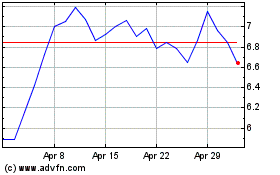
Verrica Parmaceuticals (NASDAQ:VRCA)
Historical Stock Chart
From Apr 2023 to Apr 2024
